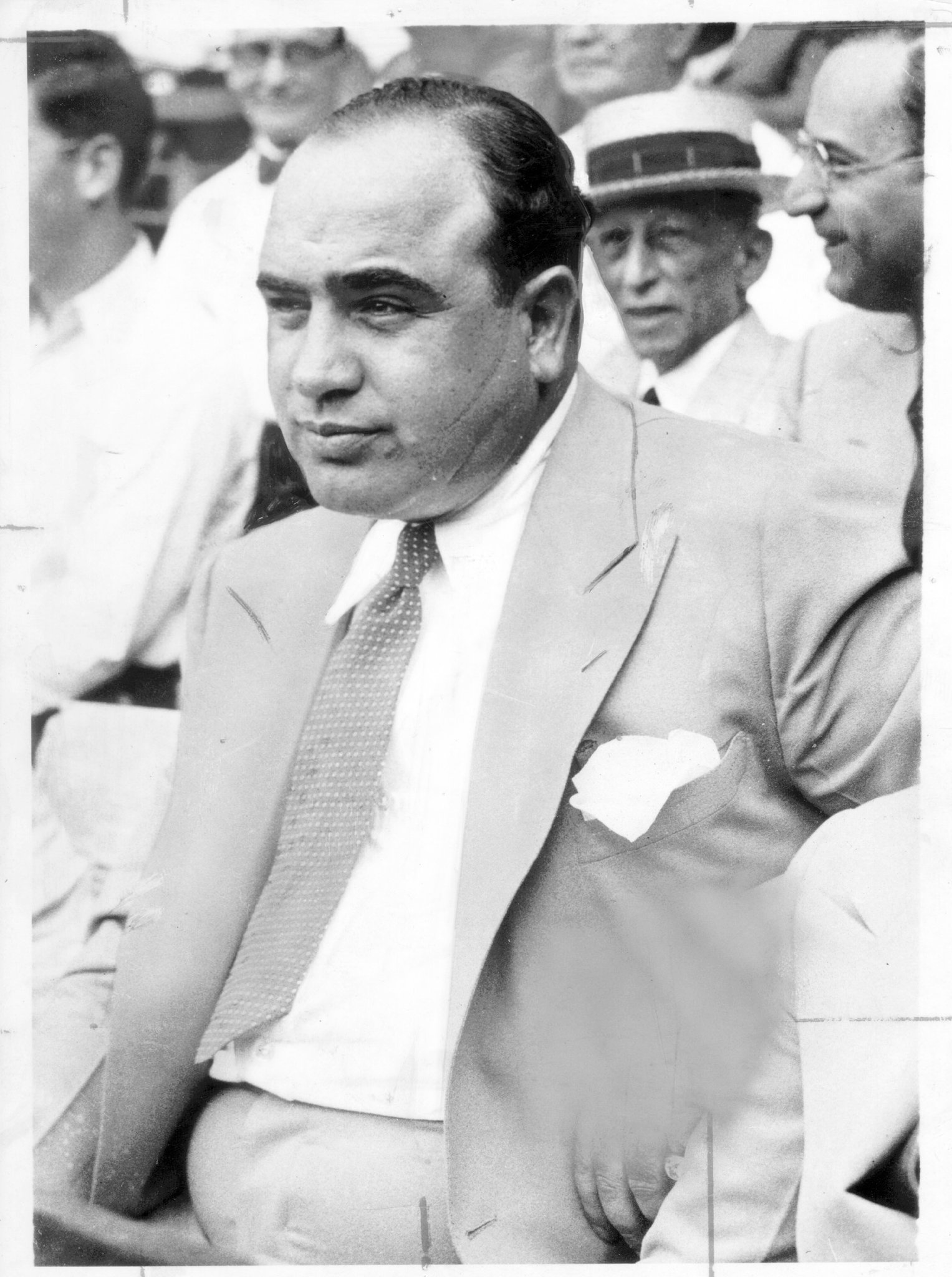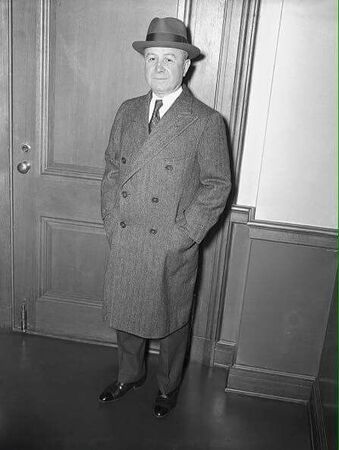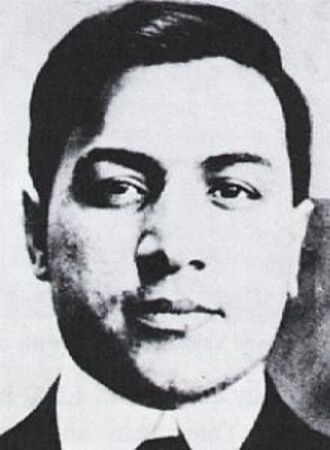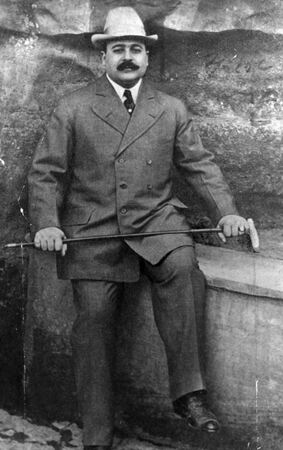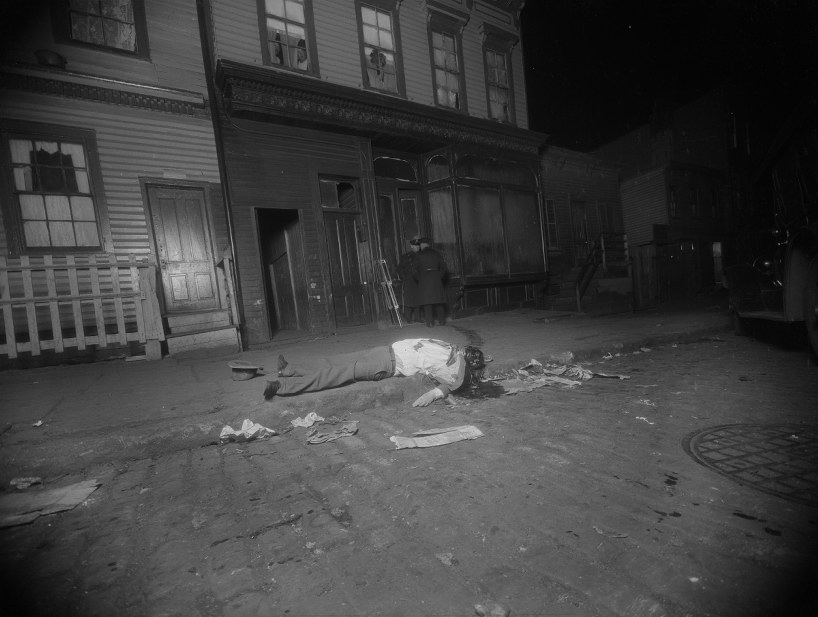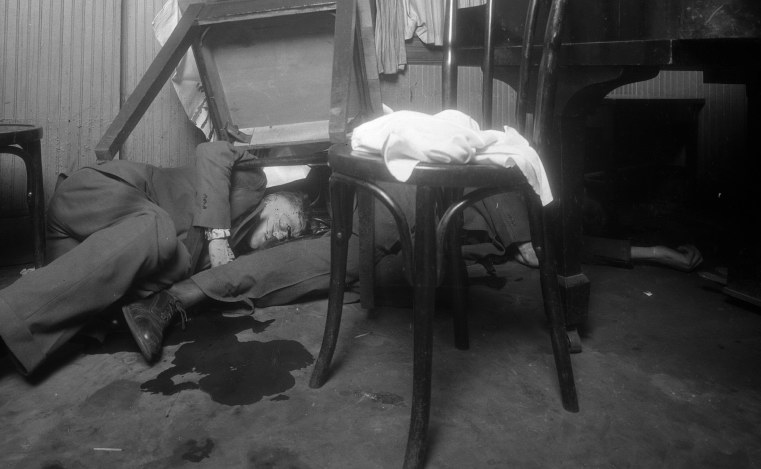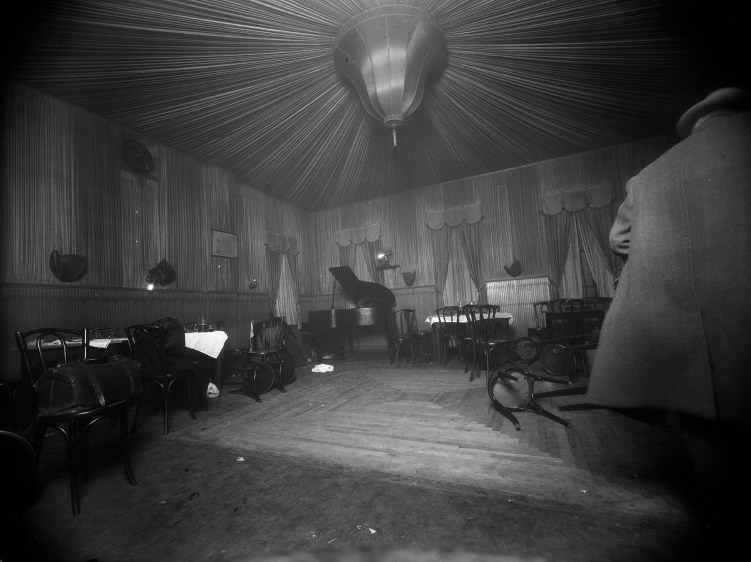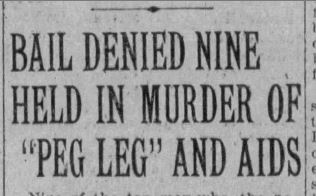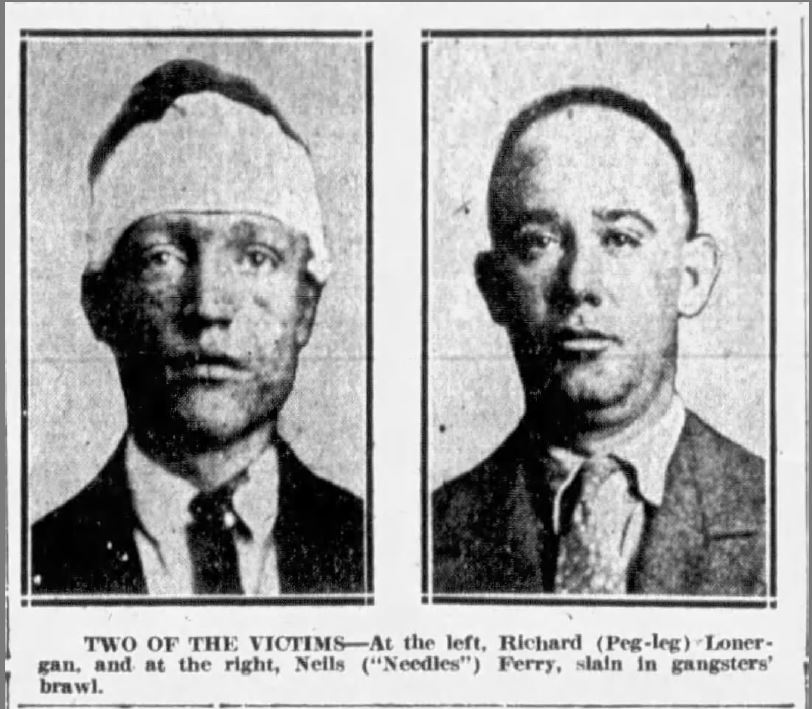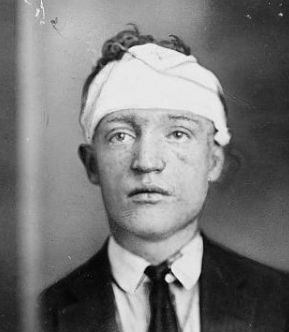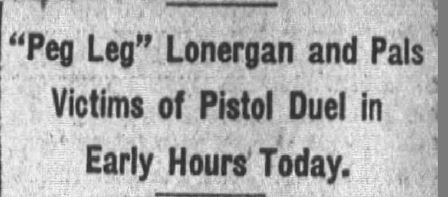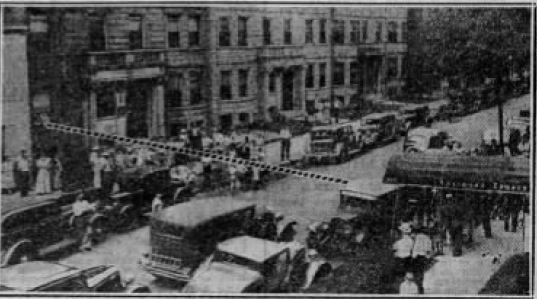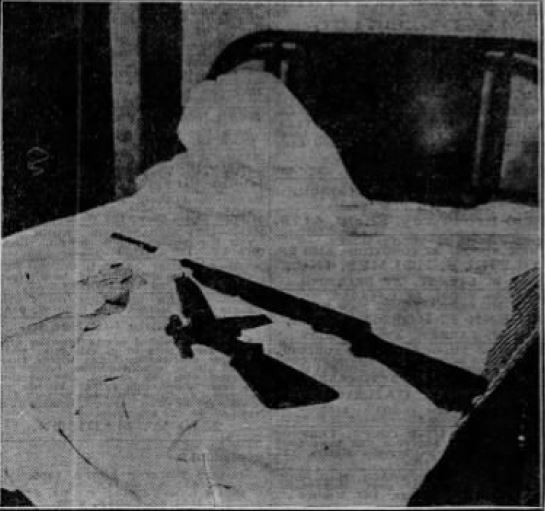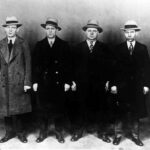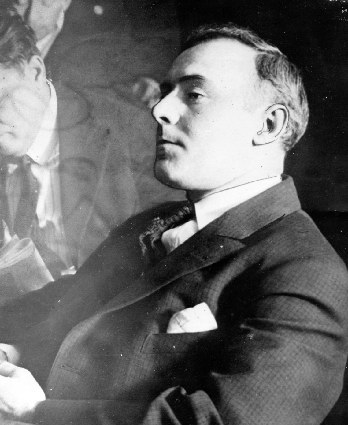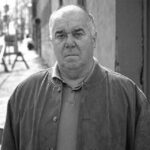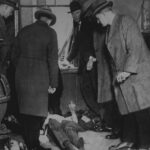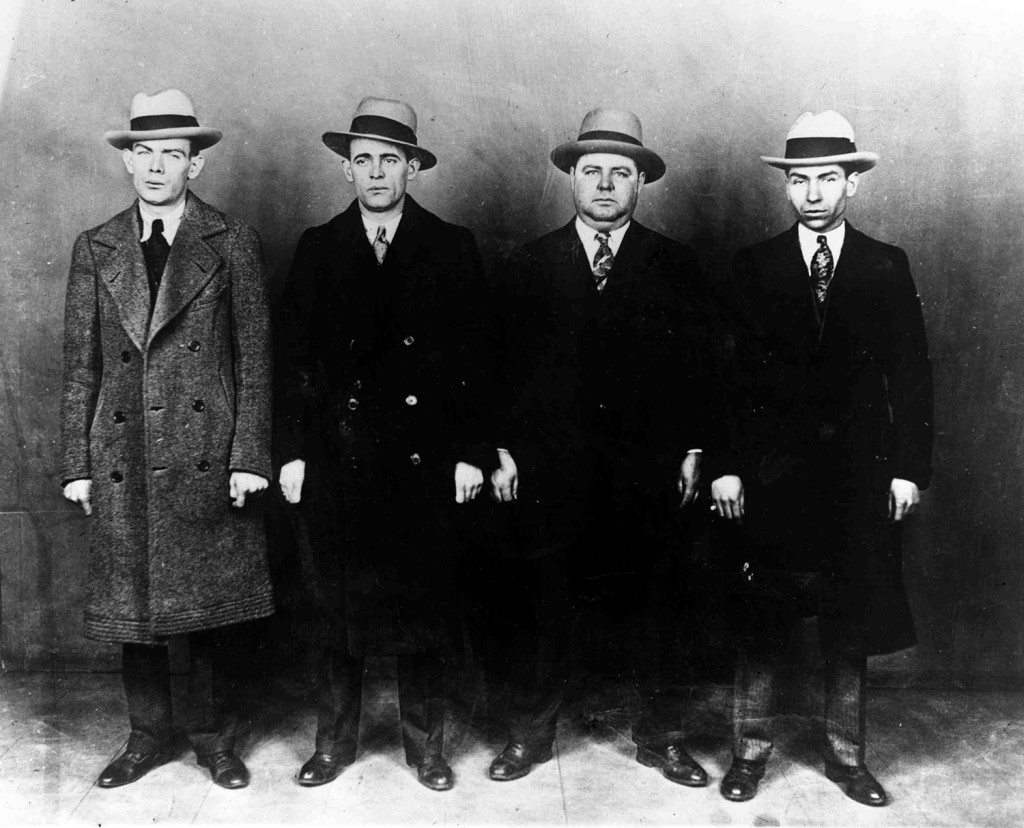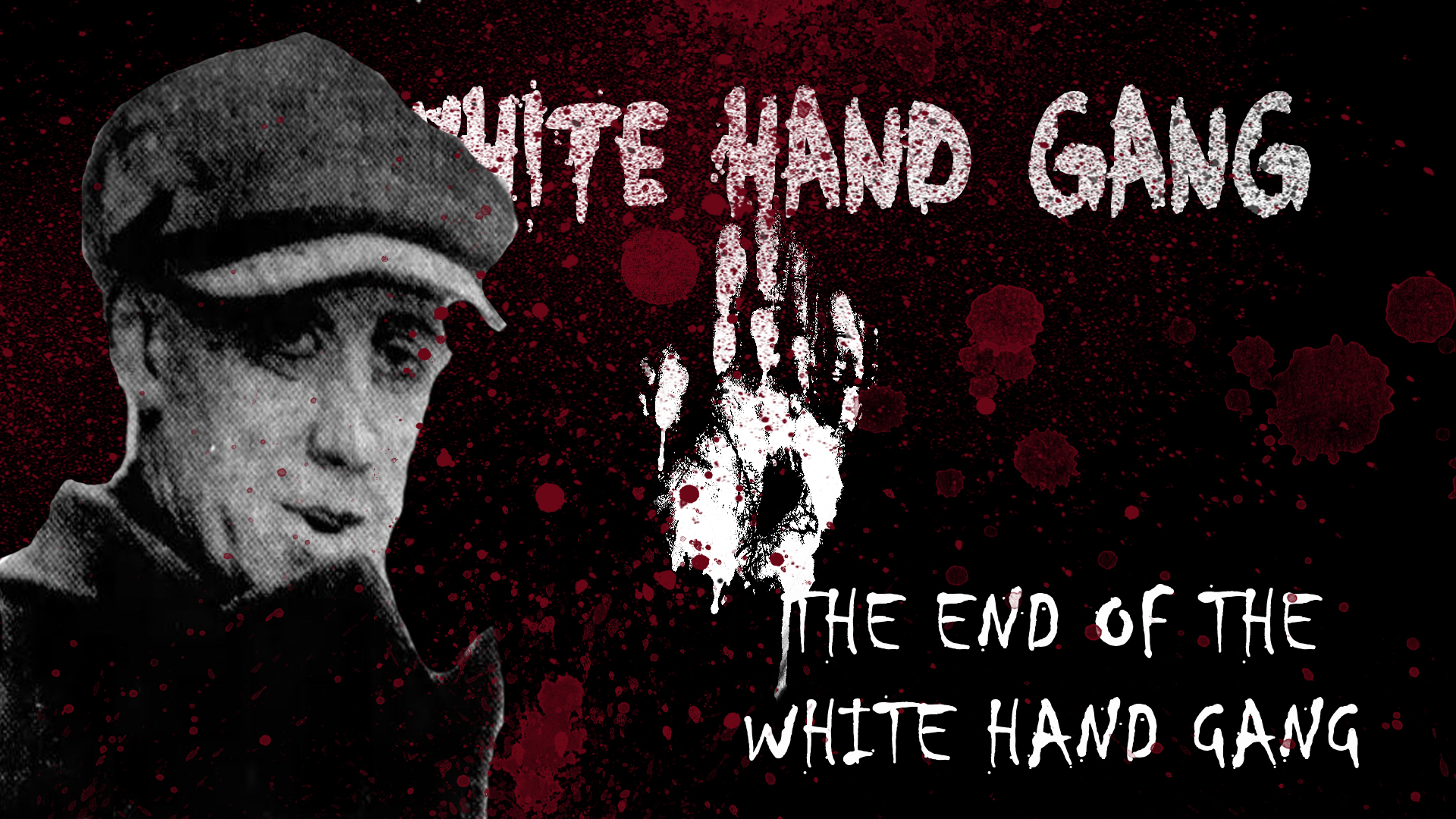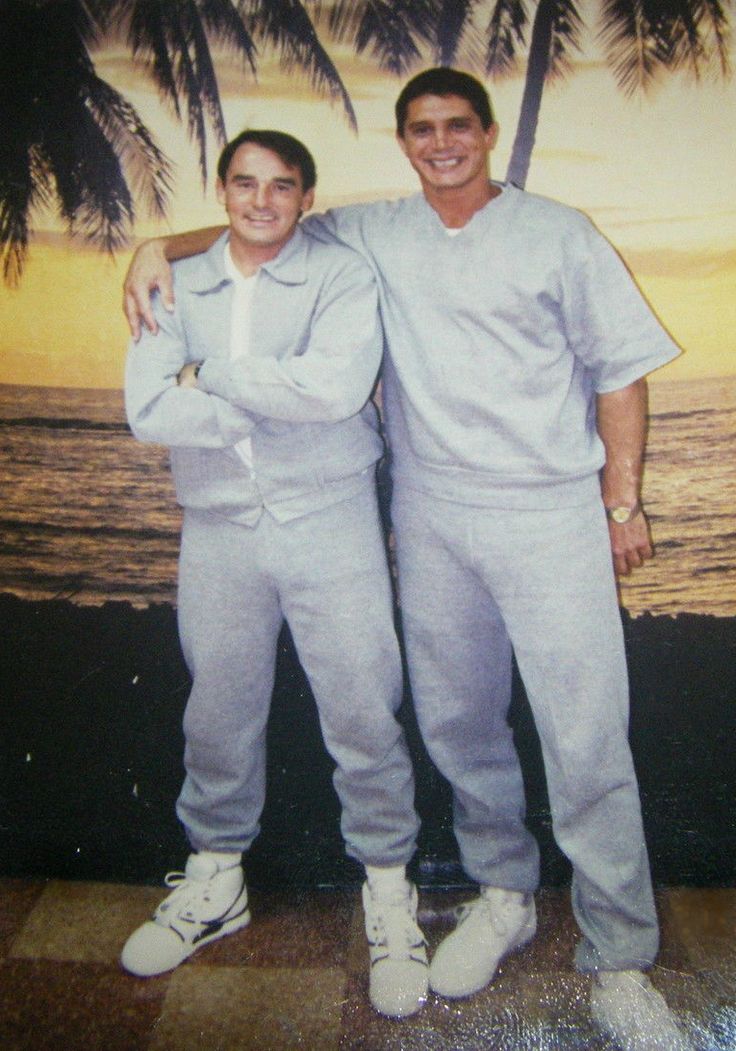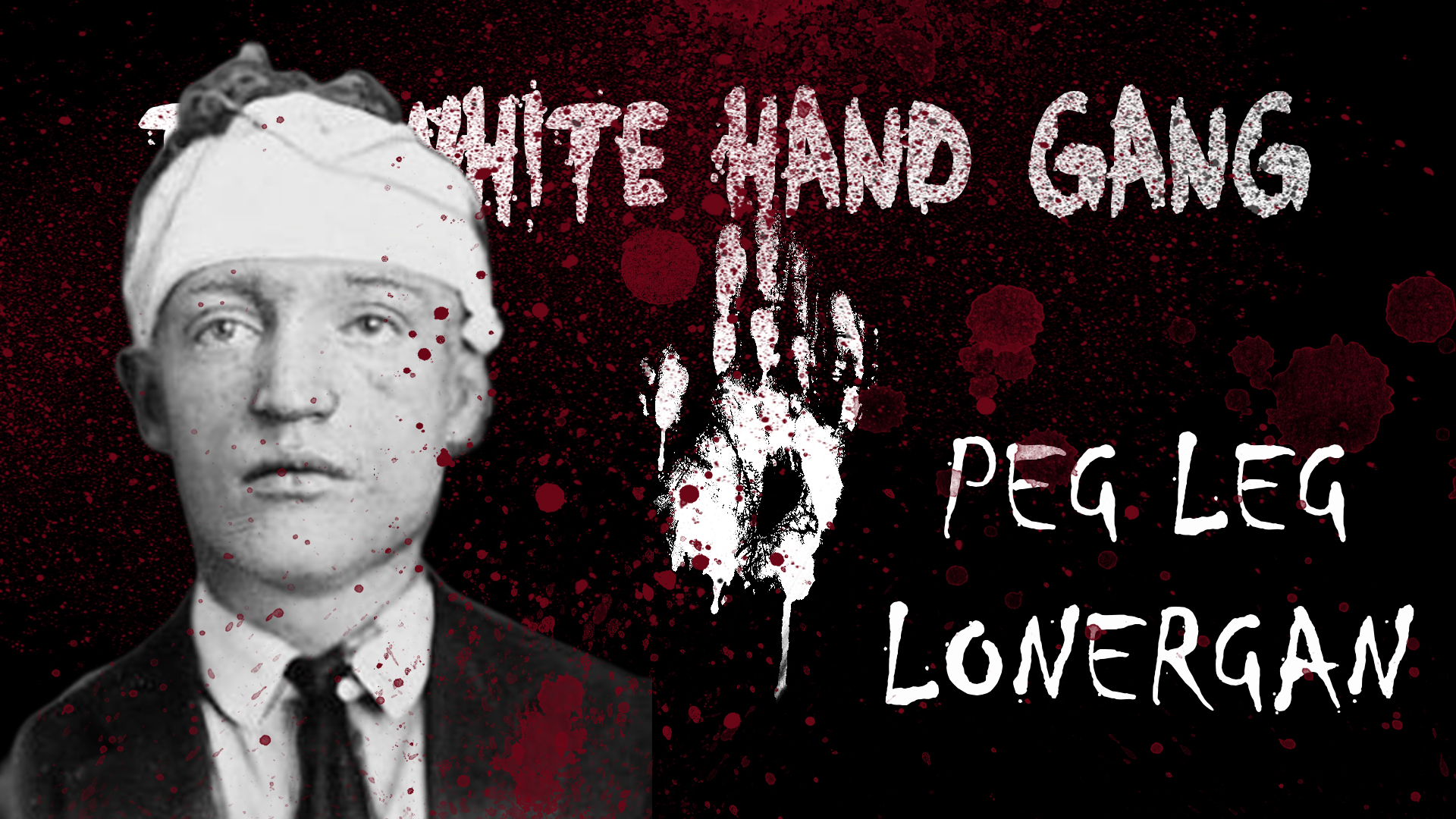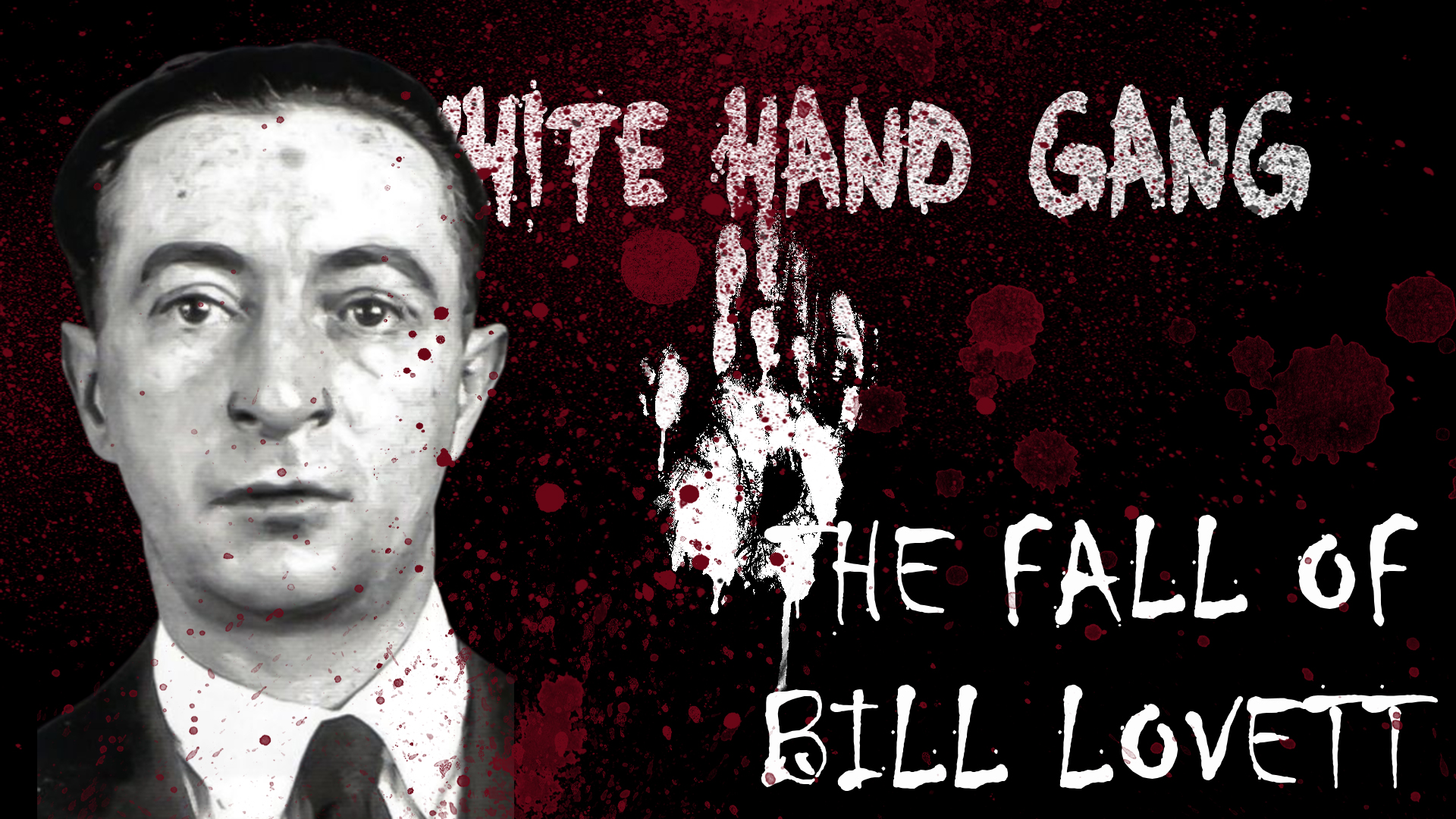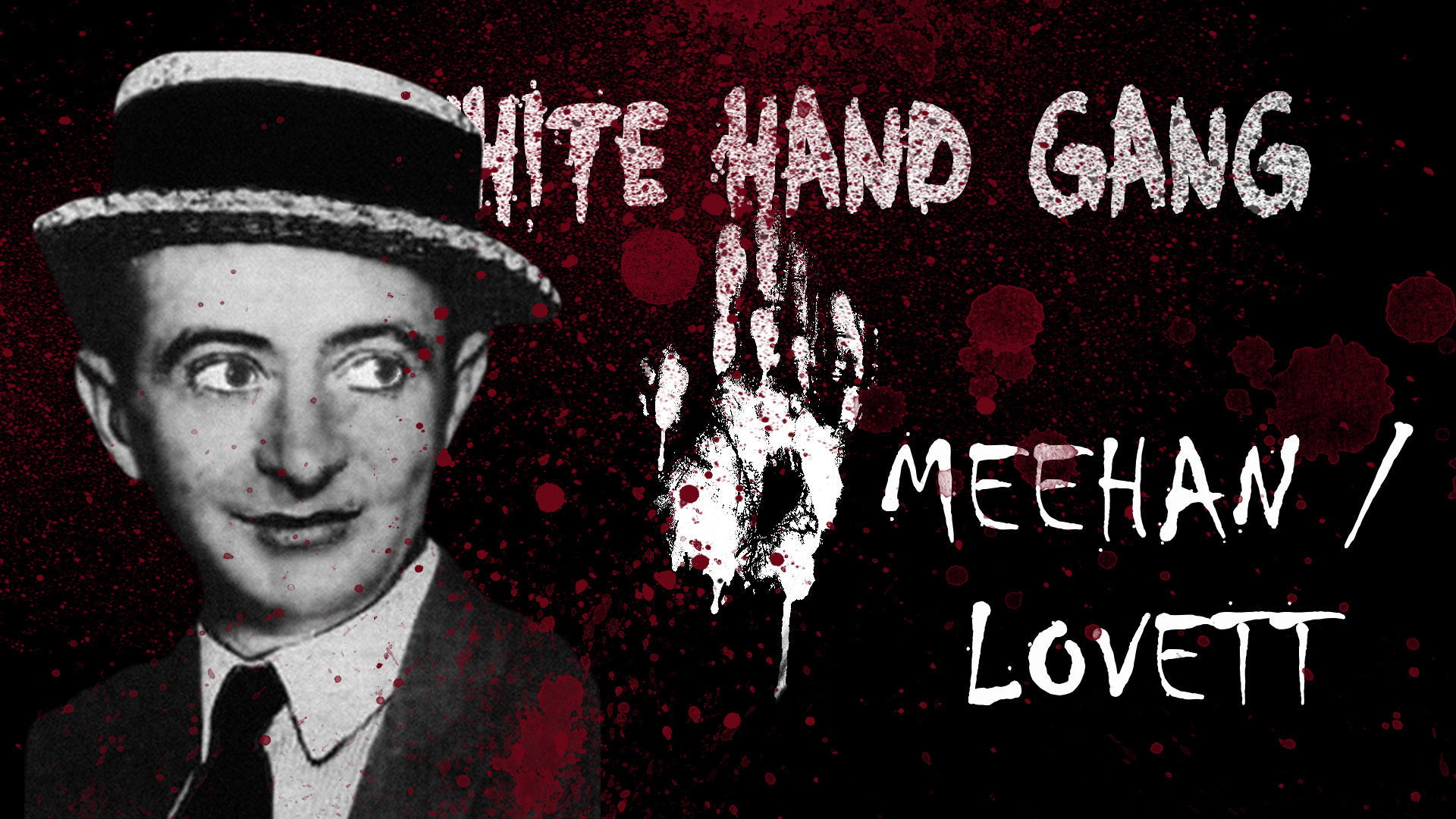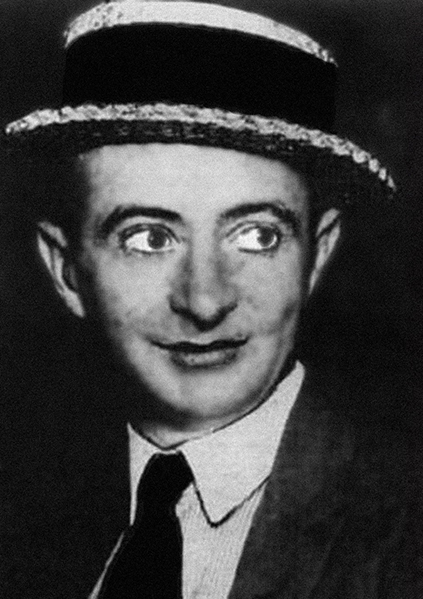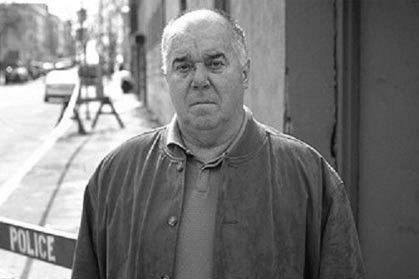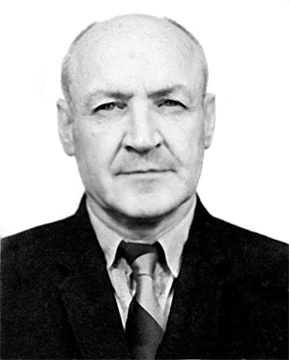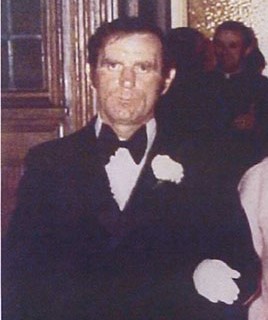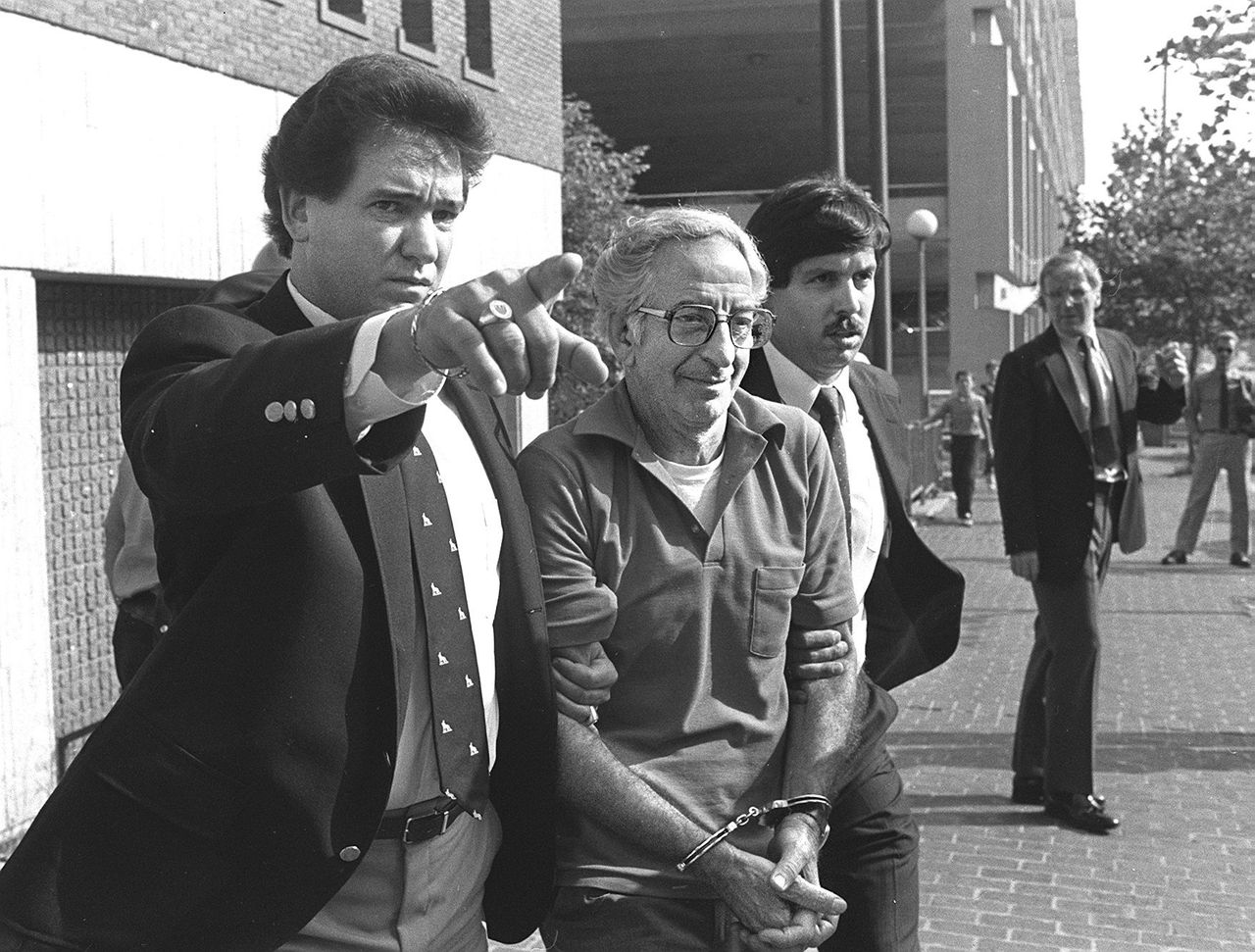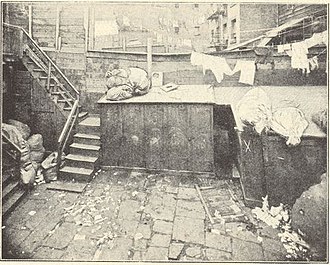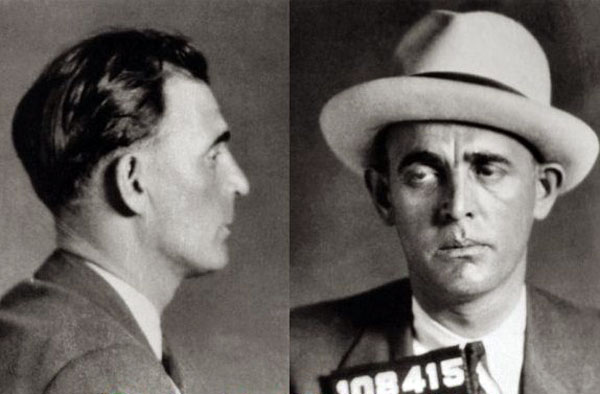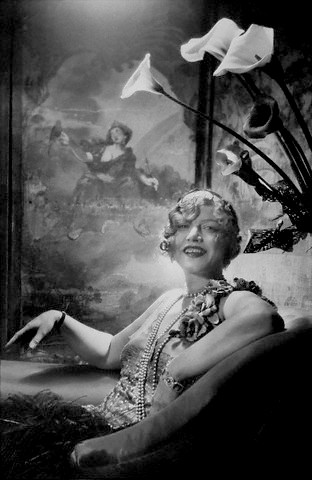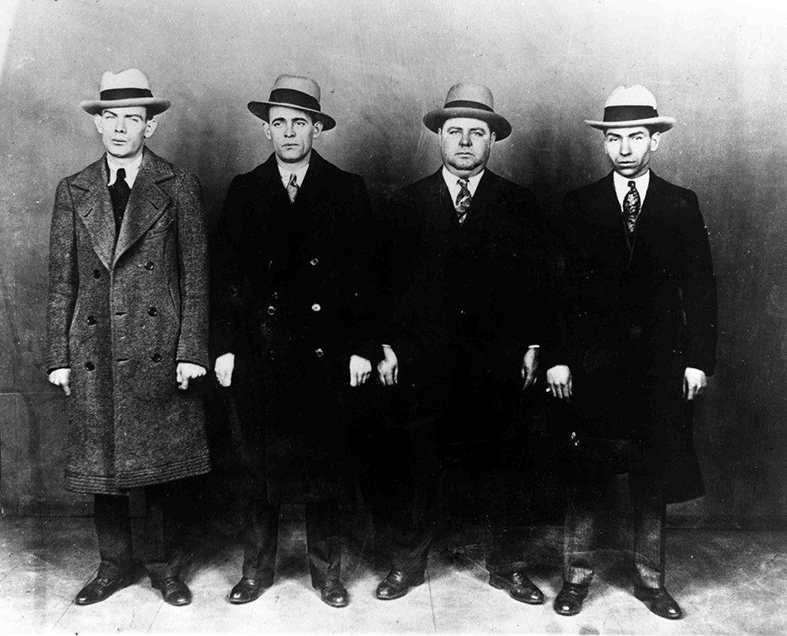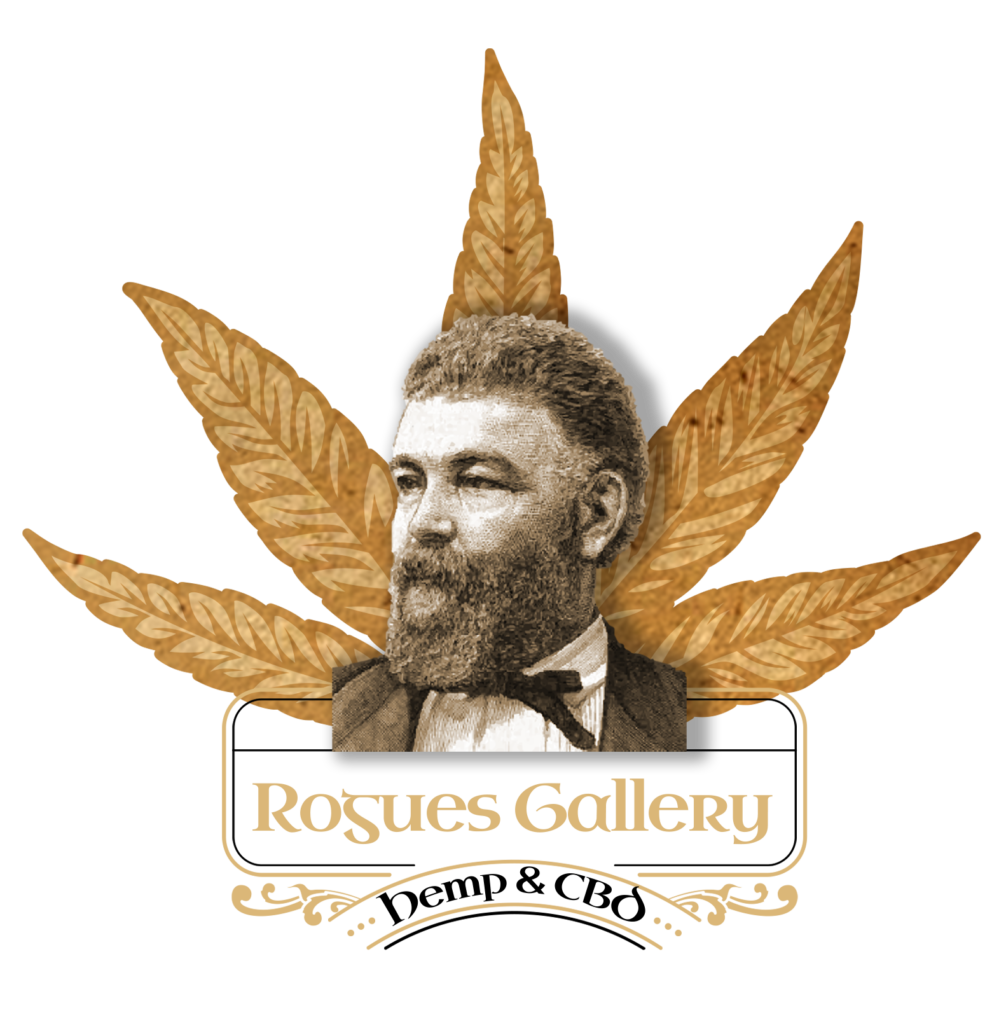Alphonse Capone or just Al Capone instantly recognizable as one of the most notorious and well-known figures of the Twentieth Century. He had many other aliases, Snorky, Scarface, Scarface Al, and Al Brown, used furniture salesman. Capone was both an ally and enemy to many Irish mobsters throughout Chicago during the Prohibition Era.
A lot has been written about Capone over the last hundred years, but in this story, we will just focus on the interactions with Irish and Irish-American gangsters.
Although Al Capone is associated with Chicago, Illinois, Capone was born in Brooklyn, New York. Capone’s parents emigrated from Italy and settled in Brooklyn in 1893. His parents, Gabrielle and Teresa had nine children in total. Al and his two brothers Salvatore or Frank and Raffaele or Ralph “Bottles” were associated with crime and prohibition.
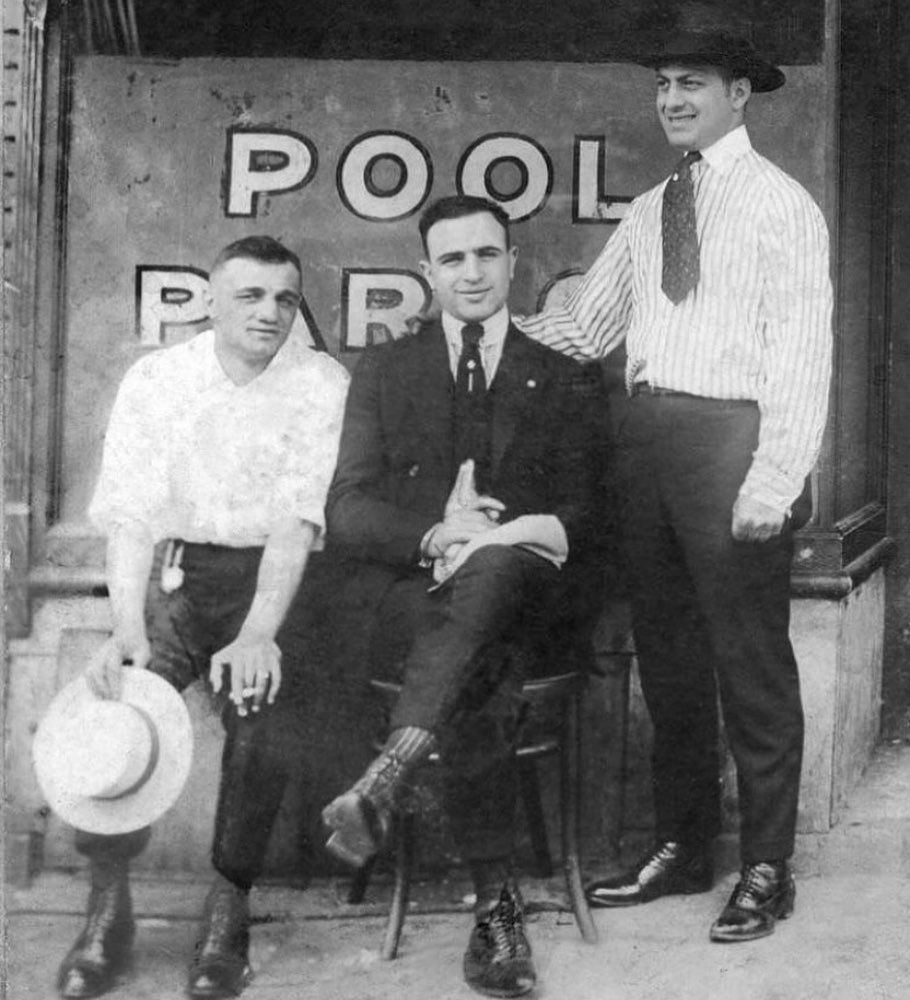
Al Capone with his father and uncle
He became a successful Prohibition Agent in Nebraska and later an agent for the Bureau of Indian Affairs, he was also known for his cowboy style. Much later in life, Richard made efforts to reunite with his family, meeting with his mother and brothers, including Al.
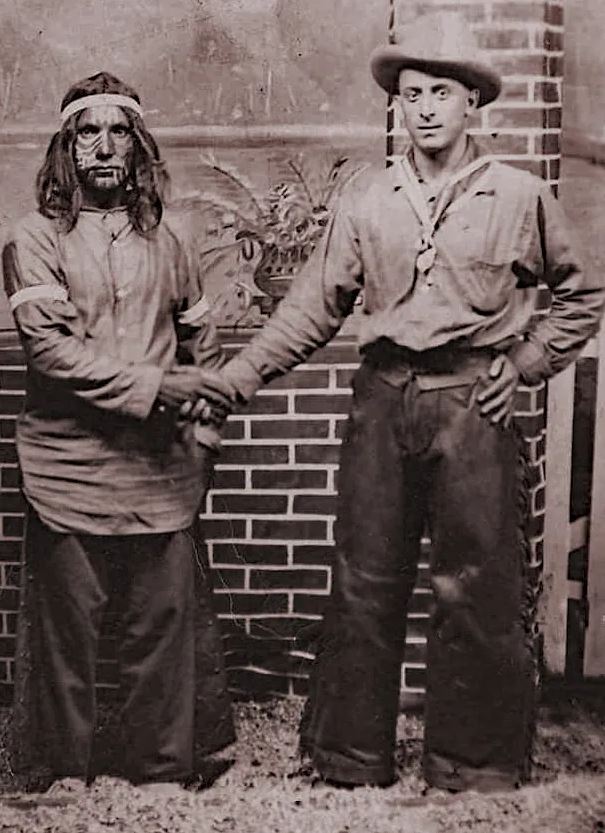
Vincenzo Cappone / Richard James “Two Gun” Hart Photograph – Jeff McArthur.
When Al Capone was a teenager he came in contact with a local Brooklyn mobster, Francesco Ioele or Frankie Uale better known as Frankie Yale, who ran a bar called the Harvard Inn, the location where Al Capone insulted a woman, in turn, led to her brother, Frank Gallucio “defending his sisters honor” and slashed Al, leaving him with the famous scars. In an added twist, years later, Capone employed Frank Gallucio, as a sign of no hard feelings.
Al Capone was self-conscious about the scars and hated the nickname “Scarface”, some accounts say he was ashamed of how he got the scars and would sometimes powder his face in an effort to hide them. He would often make attempts to hide them in photo’s, always trying to have his photo taken from the opposite side or with the camera at an angle so that the scars couldnt be seen.
Through his association with Frankie Yale, Capone met another man who would influence his rise to become one of the most recognizable names in history, John Torrio also known as “The Fox” or “Papa John”. John Torrio was a gangster from the Navy Yard area of Brooklyn who went to Chicago to his cousin “Big” Jim Colisimo, one of the biggest gangsters in Chicago, a move that would change the course of history.
Mary Josephine Coughlin was born and lived in the Carol Gardens section of Brooklyn in 1897. Her parents Michael Coughlin & Bridget Gorman were immigrants from Ireland, though their county of origin is not known.
Known as Mae she would marry Al Capone and stay married to him right up till he died in 1947. They had one son, Albert Francis “Sonny” Capone.
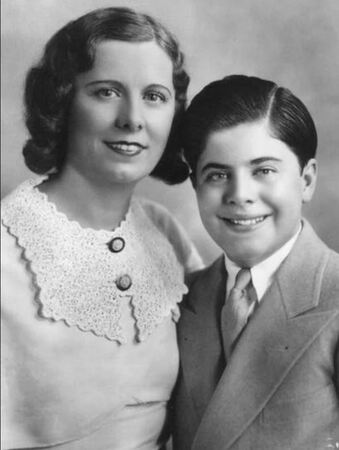
Mae & Frances “Sonny” Capone
A code of silence was observed in Irishtown, more faithfully than Omerta is observed by the mafia. Nobody ever talked in Irishtown
Willie Sutton
Become A Supporter
If you like what we do and would like to support our work, please consider donating.
Liking, Sharing and Commenting on our social media is always the best way to show support
The White Hand Gang
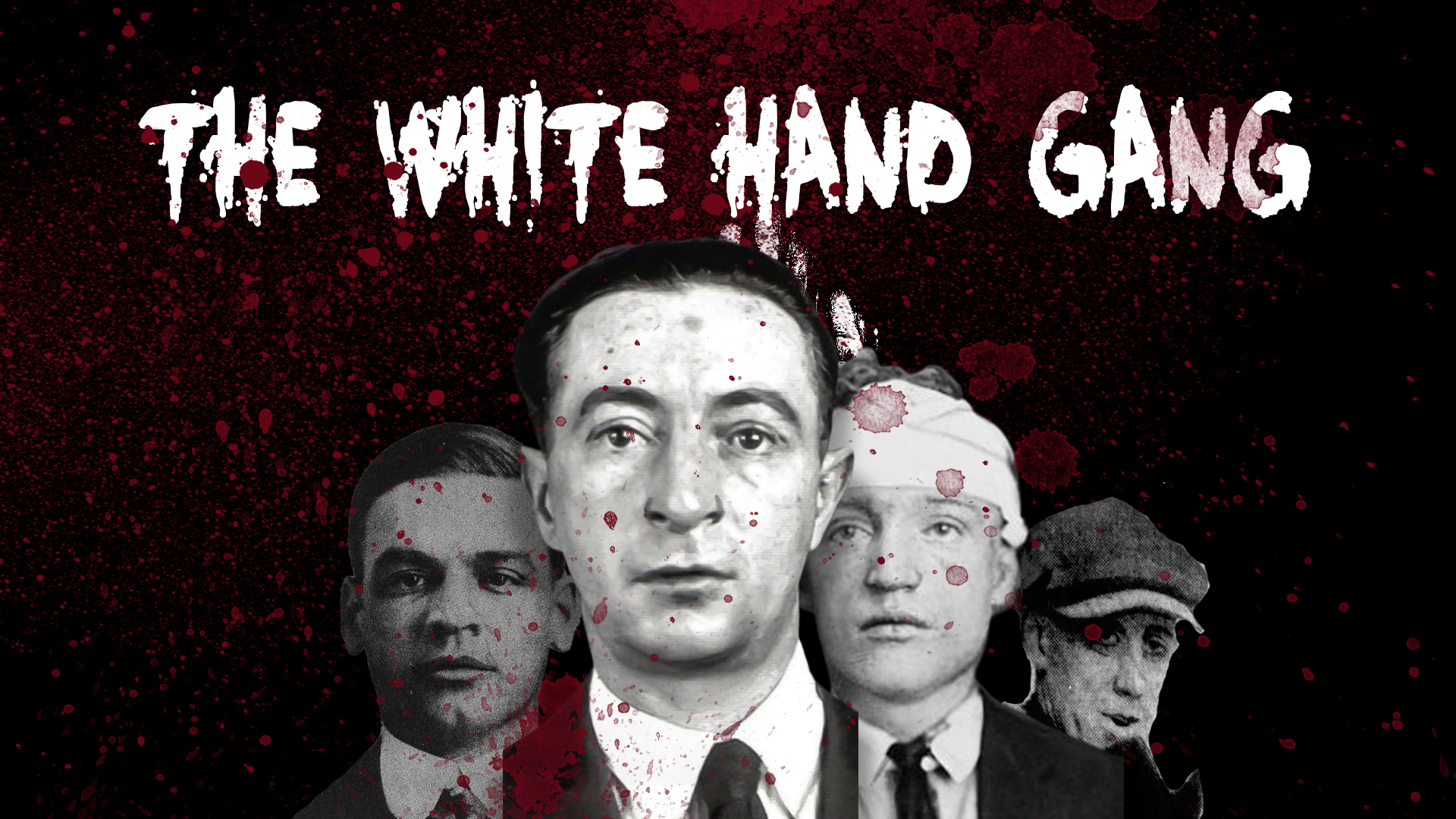
While a mob war between the Italian’s and Frankie Yale’s gang in particular and the White Hand Gang does sound exciting, the truth is there isn’t much evidence that this mob war happened, all the evidence points to an internal feud within the White Hand Gang itself, which was also known as the Bill Lovett gang, in a battle for the leadership, with multiple murders and successive leaders, “Dinny” Meehan, “Wild Bill” Lovett and Richard “Peg Leg” Lonergan being killed.
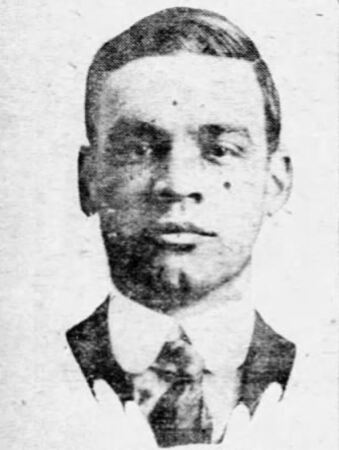
Dennis “Dinny” Meehan
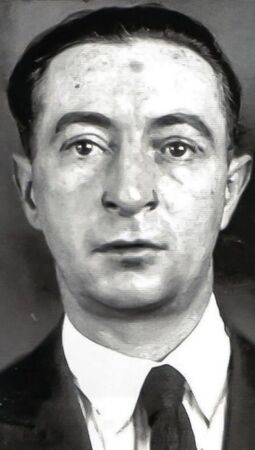
William “Wild Bill” Lovett
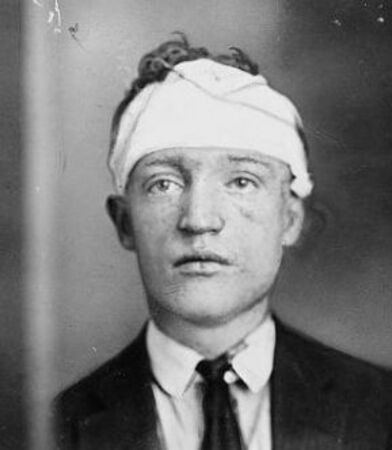
Richard “Peg Leg” Lonergan
Please watch the four part documentary including my research on the White Hand Gang here…
The murder of Richard “Peg Leg” Lonergan, was a high-profile murder for several reasons, it occurred in Italian territory, which led to speculation that Lonergan and his men were ambushed in a plan hatched by Frankie Yale and Al Capone.
One theory suggests that a disgruntled White Hand gangster named Eddie Lynch set up Lonergan, but Lynch was in prison at the time. Eddie Lynch was also found dead later in the 1920’s, believed to be in relation to the ongoing murders within the White Hand Gang.
Prostitution and pimping seemed to be a contentious issue between the Italian and Irish gangsters, for example, Dean O’Banion in Chicago also found this a contentious issue between himself and John Torrio. And other gangsters would also look down on pimping.
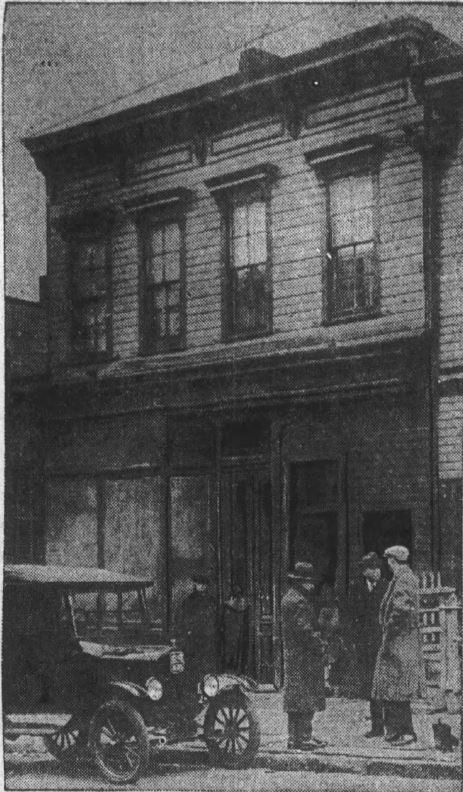
The Adonis Social Club
Lonergan’s group were sitting at a table, at a table across from them were four other men, presumably Al Capone and his group. Needles Ferry was summoned to the table with the four Italians, words were exchanged between the groups. And then the lights went out and the shooting started. By the time the shooting stopped, Aaron Harms and Peg Leg Lonergan were dead on the floor, while Needles Ferry was dead outside. All the other occupants had vanished, the two eyewitnesses left, hailed a taxi, and went home.
Patrolman Richard Morano, who was on patrol in the area, found the body of Needles Ferry outside with a trail of blood going back into the building, it’s believed that Ferry was shot in the face and stomach and was left outside by his friends. Patrolman Morano went inside to investigate where he found the bodies of Peg Leg Lonergan and Aaron Harms lying side by side they were shot in the head and chest. A gun was found near Peg Legs’ body, while another was found near Aaron Harms and two more behind the bar.
Police then started rounding up the other suspects, the following day Anthony Desso, Furi Agoglia, and the barman John Stible were taken into custody. Later, Ralph D’Amato, George Carrozza, Frank Piazza, and Al Capone were taken into custody and held. Al Capone was visiting from Chicago at the time. All were released without charge due to lack of evidence.
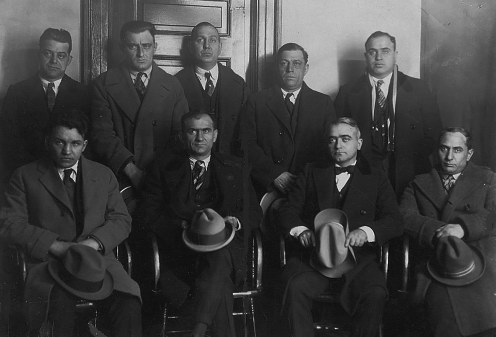
Al Capone, George Carrozza, Frank Piazza, Joe Howard, Andrew Desso, John Maloney, Sylvester Aggolia, Ralph D’Amato, and John Stabile.
Other murders were attributed to Frankie Yale and Willie “Two-Knife” Altieri too that seem to be wrongly attributed, or not enough evidence to conclude they were involved.
In one story, for example, the murder of “Dinny” Meehan, it appears that “Wild Bill” Lovett was responsible for Meehan’s murder, Dinny Meehan’s wife, Sadie, identified Lovett years after his death.
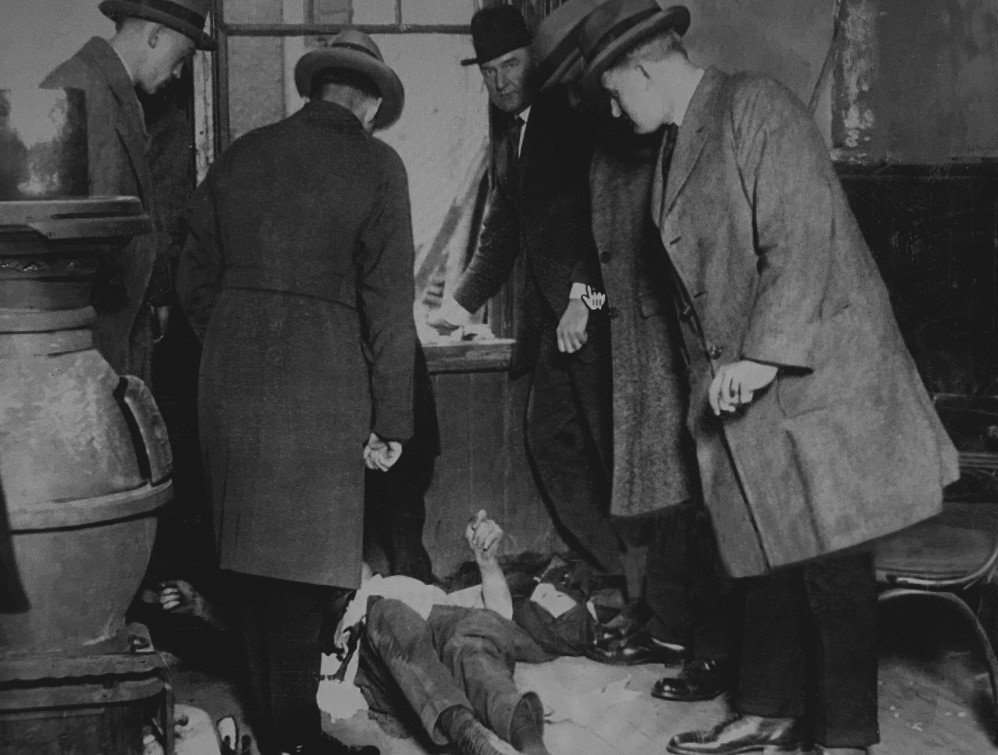
“Wild Bill” Lovett Murder Scene
One theory about Lovett’s death suggests that his murder was revenge for “Machine Gun” Jack McGurn’s father, Tommasso Gibaldi. The only Italian, that “Wild Bill” Lovett was in a restaurant, Lovett and a man named “Red” Donnelly were brought in for that.
However, the truth is that it’s more than likely that John Torrio asked Capone to come to Chicago after Capone’s father had a heart attack. Torrio saw a lot of potential in Capone. Al Capone headed out to Chicago in 1919. In 1920 “Big” Jim Colisimo was murdered, possibly on the orders of John Torrio. This meant John Torrio was now the boss of the outfit and Capone was his protégé.
Frankie Yale was killed in a car chase, by unkown gunmen in 1928., allegedly on the orders of Al Capone. The relationship between Yale and Capone had become strained.
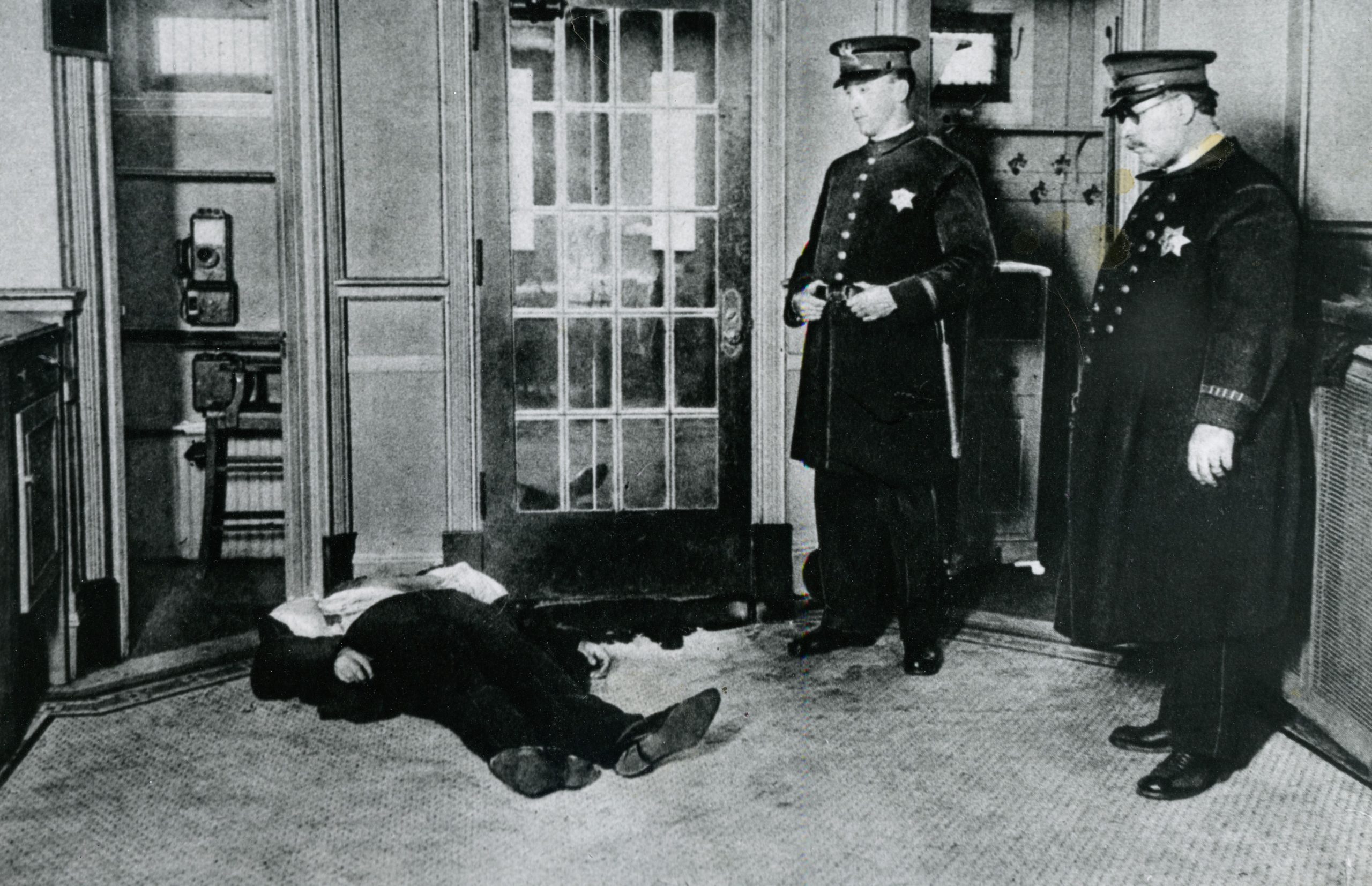
“Big” Jim Colosimo Murder Scene
The decision to whack Colosimo was accepted without many repercussions, Colosimo was seen as reluctant to get into the bootlegging trade, crooked local politicians such as “Hinky Dink” Kenna & “Bathhouse” John Coughlin, bosses of Chicago’s red light district, stated that all previous arrangements would continue to be honored.
John Torrio was initially based in the notorious Four Deuces establishment on Wabash Street. The Four Deuces had a saloon on the ground floor, the second and third floors were gambling and casinos, and the fourth floor was used as a brothel. Capone began working in the Four Deuces, as a bouncer and as someone who would stand outside and bring in clientele to the brothel. He then later became part owner and manager.
Capone then opened a “front business” near the Four Deuces, a used furniture store, he would also start using the alias, Al Brown.
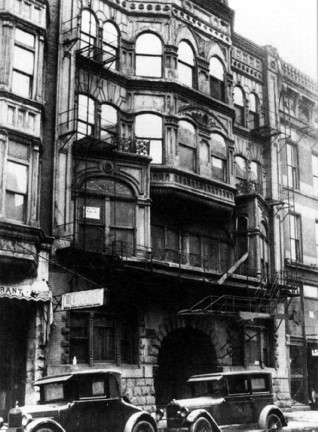
The Four Deuces as it stood in the 1930’s deadlyvalentines.com
"Ragtime" Joe Howard
That evening, two men entered the saloon and began to talk with Howard. Witnesses say one man was described as short while the other was big and stocky. They asked Howard to go outside but Howard refused, it was then the big stocky man grabbed Howard by the collar put a gun to his cheek, and fired six shots quickly, Howard took four in the face and two in the shoulder
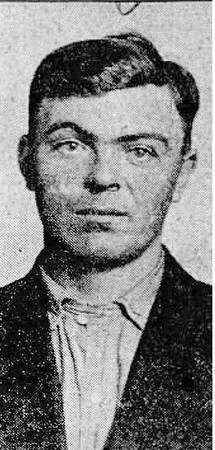
“Ragtime” Joe Howard
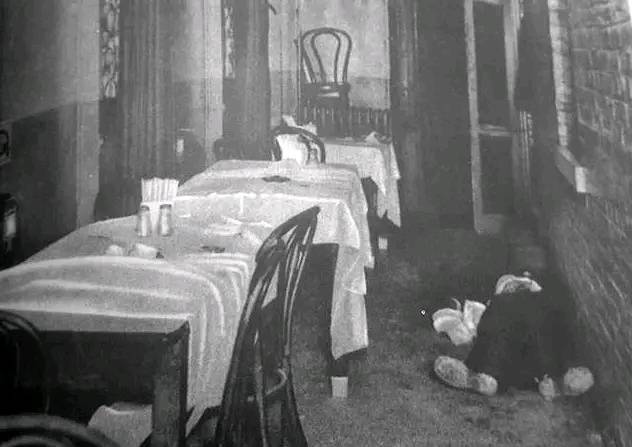
“Ragtime” Joe Howard Murder Scene
That evening, two men entered the saloon and began to talk with Howard. Witnesses say one man was described as short while the other was big and stocky. They asked Howard to go outside but Howard refused, it was then the big stocky man grabbed Howard by the collar put a gun to his cheek, and fired six shots quickly, Howard took four in the face and two in the shoulder.
Within a couple of hours, the police were looking for a man named Al Brown, who ran a speakeasy called the Four Deuces. What the police did not know, at that time was, that Al Brown was a name that Al Capone used as cover.
There were many witnesses at the saloon where the shooting took place but they had all suddenly forgotten what happened, a case of “Chicago Amnesia”. The saloon owner also just happened to be looking in his safe at the time it happened too. The three men who had been with Howard at the time all vanished.
Sometime after Howard’s murder, Al Capone turned himself in at a police station, the police in turn handed him to prosecutor William McSwiggin for questioning and later released. William McSwiggin was later gunned down by Capone’s men, mistakenly, when he was caught in the crossfire of a mob shooting.
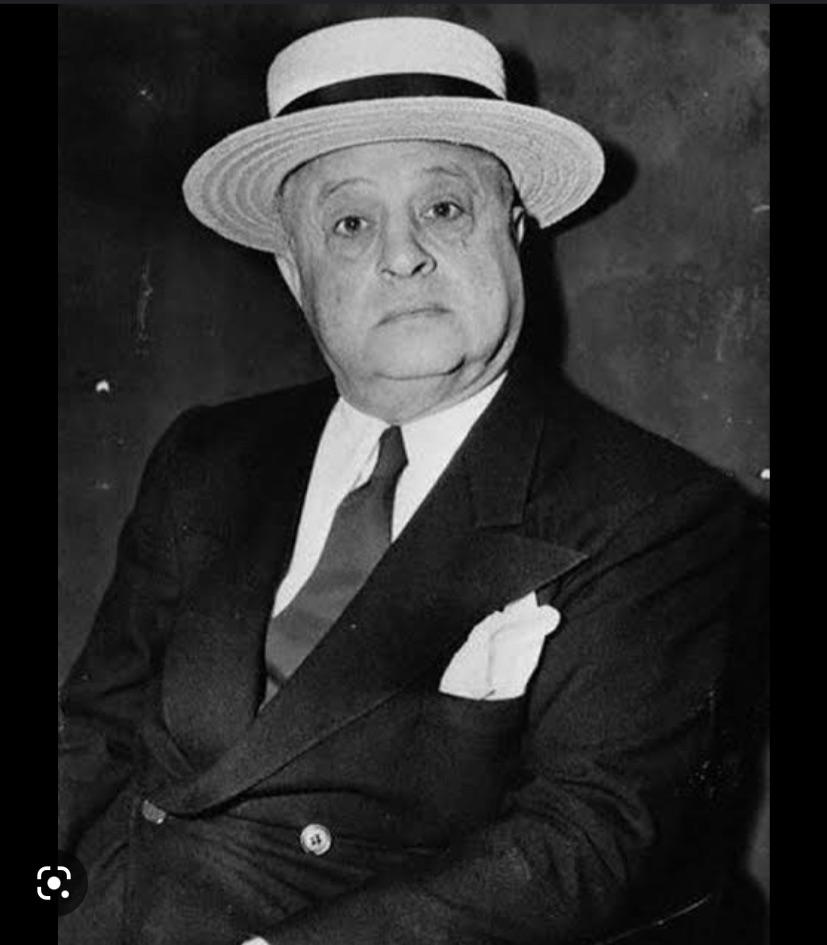
“Greasy Thumb” Jake Guzik
Guzik tried to talk Howard out of the robbery by offering him a job. Ragtime Joe sneered he’d never work for a pimp like Capone.
Become A Supporter
If you like what we do and would like to support our work, please consider donating.
Liking, Sharing and Commenting on our social media is always the best way to show support
The Westside O'Donnell's
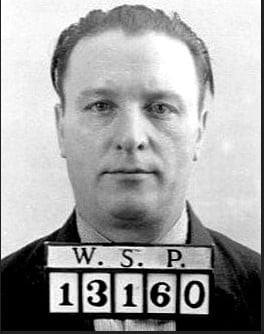
William “Klondike” O’Donnell
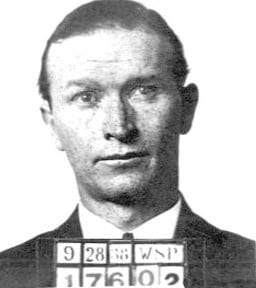
Myles O’Donnell
Myles O’Donnell was arrested and stood trial for the murder of Eddie Tancl in what became a running dispute between Tancl and the O’Donnell’s because of selling beer in Cicero, Illinois, which was also considered Westside O’Donnell territory.
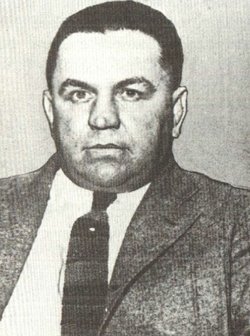
Eddie Tancl
In November 1924 Myles O’Donnell and James Doherty paid a visit to the Hawthorne Park Inn to see Eddie Tancl. It is worth pointing out that this Hawthorne Park Inn is different from Al Capone’s Hawthorne Hotel. An argument broke out in the bar between them which turned into a gunfight. Doherty and O’Donnell turned the guns on Tancl, Tancl then pulled his gun but the other two fired at him, Tancl also fired but his gun jammed.
O’Donnell and Doherty ran out of the bar and split up, Tancl followed O’Donnell, both firing their guns at each other, hitting each other and both fell on the ground. A barman from Tancl’s bar had followed them and just reached both Tancl and O’Donnell in time to take Tancl’s gun from him. Tancl’s last words to the barman were “Kill him, he got me.” The barman jumped on O’Donnell until the police arrived.
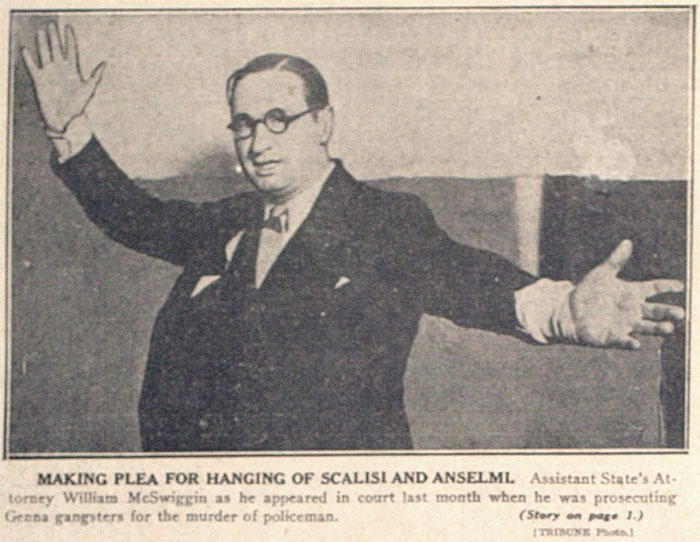
William McSwiggin
On April 27, 1926, McSwiggin joined Jim Doherty, Klondike, Myles O’Donnell, and Thomas “Red” Duffy, a childhood friend of McSwiggin for a night out in Cicero. All of them went to Harry Madigan’s bar, The Pony Inn, where they were joined by another man named Edward Hanley. As they left the Pony Inn a car pulled up alongside them and the passengers opened fire on the group, the O’Donnell brothers and Edward Hanley dropped to the ground, avoiding being hit but McSwiggin, Doherty, and Duffy were all riddled with bullets.
In the aftermath, Hanley and the O`Donnells sped off with McSwiggin and Doherty, who both died in Klondike`s car. Duffy was left behind and was taken by a motorist to West Suburban Hospital, where he died the following morning.
It was later revealed that the Capone gang and the O`Donnell brothers had had a tiff and were on the verge of open warfare. Rumor has it that Capone was behind the gun or in the car that the gun was fired from, and to witness for himself the firepower of the Tommy Gun.
Tensions between the Westside O’Donnells and the Capone gang were eased when Capone left town for a while until the heat died down.

William “Klondike” O’Donnell, William “Three-Fingered Jack” White, Murray “The Camel” Humphreys, Marcus Looney, and Charles Fischetti.
Other notable names in attendance were, Vincent “Schemer” Drucci and George “Bugs” Moran from the North Side Gang, Ralph Sheldon attended, Joe Soltis and Frank McErlane were represented, although both Frank McErlane and Joe Soltis were in prison at the time. Al Capone was represented by Tony Lombardo. They agreed to peace but it didnt last long, within months they were back at it again.
The Westside O’Donnell’s allied with Capone, with “Klondike” O’Donnell becoming a vital part of the labor racketeering and taking over the unions along with Murray Humphreys, Marcus Looney, George “Red” Barker and “Three Finger Jack” White to name but a few. All of these men and more were busted in a Chicago hotel executive suite in 1932, they were believed to be overseeing the corruption of unions.
Towards the end of the 1920’s and into the early 1930’s the mobsters branched out from bootlegging, gambling and prostitution into labor racketeering
Dean O'Banion
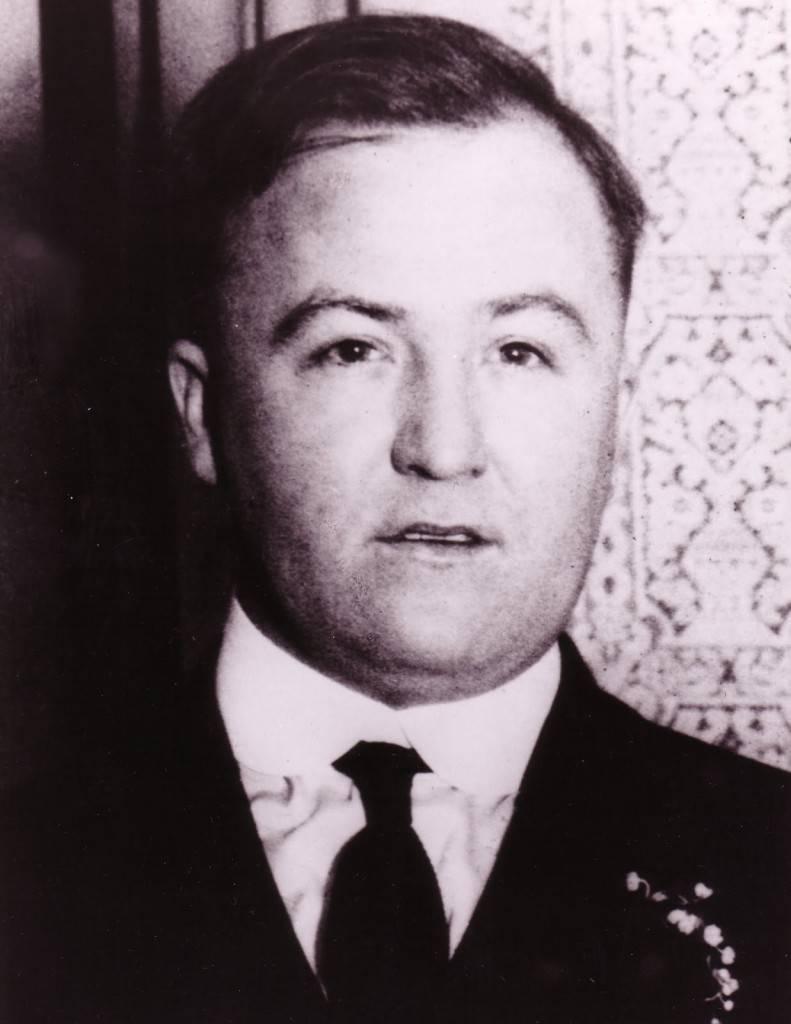
Dean Charles O’Banion
It would seem that this is where Capone would learn the importance of peace and profit over needless mob warfare or reacting on impulse and anger. John Torrio’s patience would rub off on Al Capone.
Interestingly, like other young mobsters of the time in New York, such as Salvatore Lucania better known as Charles “Lucky” Luciano, Frank Costello, Meyer Lansky, etc, they would see the importance of doing business and being allies with mobsters of other ethnic backgrounds like Irish, Jews, Polish etc.
John Torrio had a plan for Chicago, he called for the other mobs to sit down and agree to divide Chicago into territories among themselves. For the most part, the territories were accepted by all, for some reason the Southside O’Donnells either did not take part in the agreement or did take part for a while then split from the agreement early on. The Southside O’Donnell’s, were not related to the Westide O’Donnell’s, went to war with the Soltis / McErlane gang, who were backed by Torrio and Capone.

Edward “Spike” O’Donnell & Frank McErlane
Duffy, who was in a panic began to reach out to people in the hopes of getting out of town, reportedly, O’Banion agreed to help Duffy and arranged to meet at The Four Deuce’s, Al Capone’s place on South Wabash Avenue. John Duffy was last seen alive outside the Four Deuce’s getting into a car by eyewitnesses, who said they had seen him getting into a Studebaker with two men. John Duffy’s body was found the following morning on a snowbank in Chicago.
Police began their investigation naturally by focusing on Al Capone, The Four Deuces was the headquarters of Al Capone’s mob operations. It was a furniture store on the first floor, under the name of “Al Brown”, but actually had a saloon on the first floor, gambling on the second and third floors, and a brothel on the top floor, and Duffy was last seen outside it. Soon though, the suspicion turned to O’Banion’s gang.
John Torrio coveted the Gold Coast territory, which was Dean O’Banion’s, and came to a compromise with O’Banion’s gang, agreeing to a sharing of profits in breweries and casinos. O’Banion accepted the deal but continued hijacking shipments, angering Torrio and Capone as some of the booze that was being hijacked belonged to them. Al Capone was incensed by what he saw as an insult and asked Torrio to care of it but to keep the peace with O’Banion, Torrio refused to deal with it.
Despite the uneasy peace between the gangs, O’Banion did work with Torrio by getting some of his gang to work with Torrio and Capone in trying to influence the results of the mayoral election in 1924, making sure that the right candidate won. During that election, Al Capone’s brother Frank was shot and killed in outbreaks of violence throughout the city.
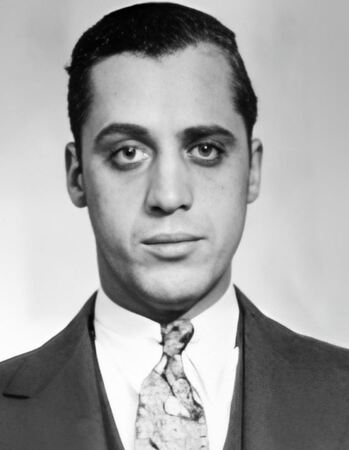
Frank Capone
O’Banion made matters worse one night at The Ship casino, with “Schemer” Drucci, Hymie Weiss, Frankie Rio, Frank Maritote, and Al Capone. As they were counting the night’s takings and dividing the profits, Al Capone brought to attention that one of the Genna brothers, Angelo, had an I.O.U for a hefty sum of money.
O’Banion, who was already in dispute with the Genna Brothers, made an issue of it and it was suggested that O’Banion let it go to keep the peace. Angered, O’Banion refused and demanded a telephone and got Angelo Genna on the phone to pay in full the $30,000 debt he owed to The Ship.
“To Hell with them Sicilian’s”
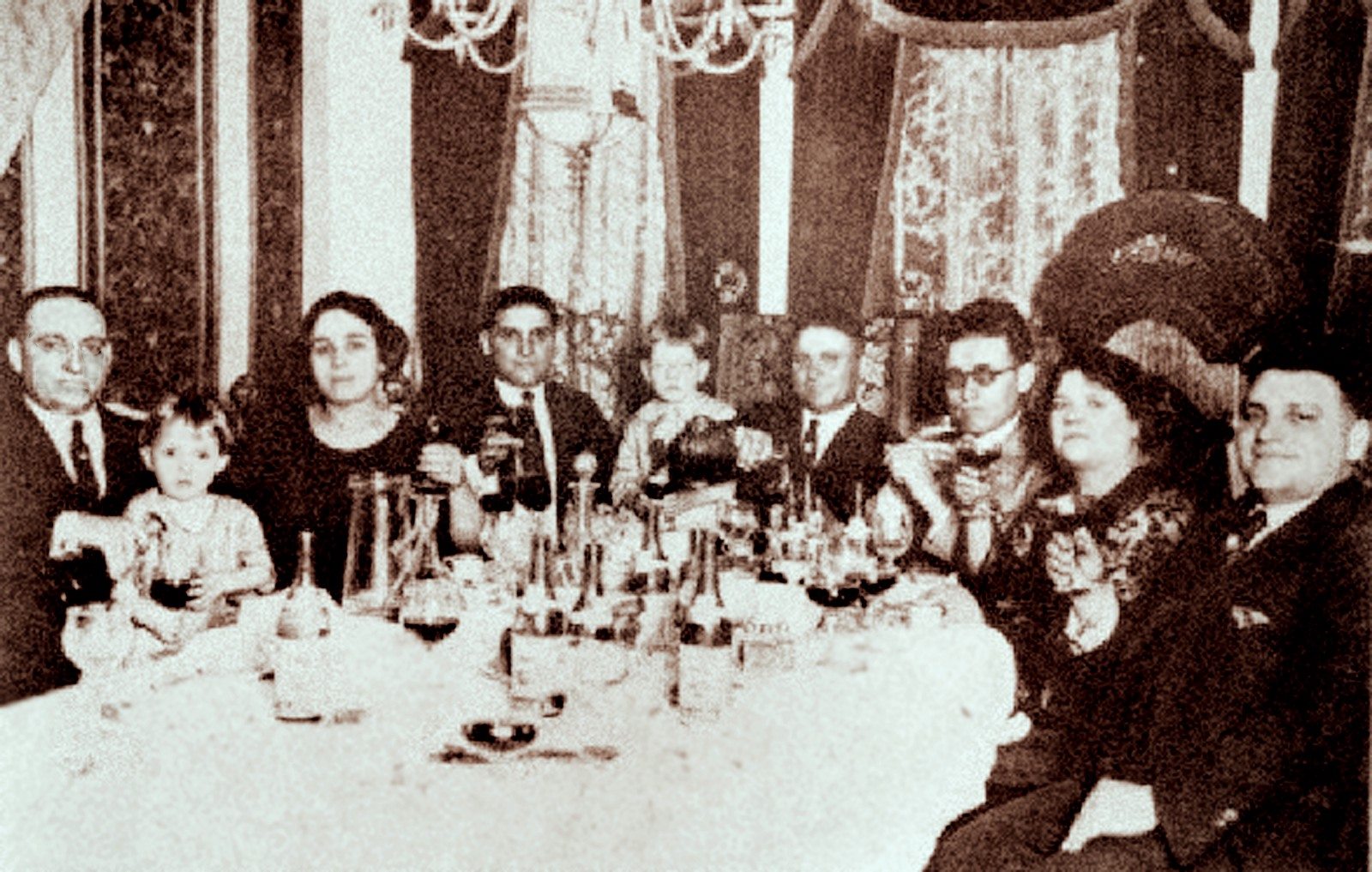
Left to right Sam, Angelo, Peter, Tony and James.
In what became the final insult Dean O’Banion tried to trick Torrio, by telling him that he was leaving the rackets and bootlegging and that he wanted to sell his stake in Sieben’s brewery on North Larabee Street.
In reality, it’s believed that Dean O’Banion had gotten a tip-off that the brewery was to be raided by the police and federal agents. O’Banion knew that John Torrio already had a charge for violating the Prohibition Laws and another violation would land Torrio a mandatory prison sentence. In the raid on Sieben’s Torrio, O’Banion and Louis “Two Gun” Alterie were all brought in by Police. It was the final straw for Torrio and O’Banion.
Al Capone was not present at Sieben’s Brewery as he was keeping a low profile since “Ragtime” Joe Howard had been murdered.
The Tommy Gun became so widely used it became known as the Chicago Typewriter, or lesser known as the Chicago Piano.
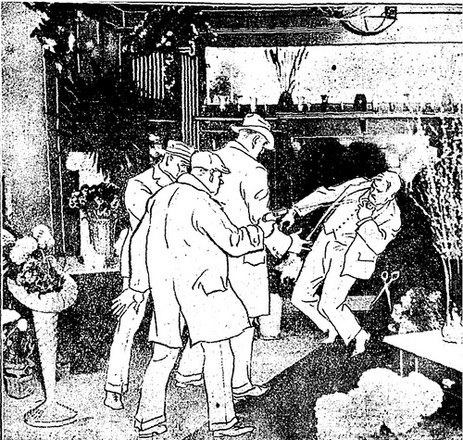
An Illustration of the scene of Dean O’Banion’s Murder / Chicago Tribune
A simple basket of roses near O’Banions casket had a condolence card attached that was sent from Al Brown, a Used Furniture Dealer, Al Brown being an alias for Al Capone. Capone was known for sending flowers to rival mobsters’ funerals. It’s not clear if John Torrio sent flowers or if Capone or Torrio attended the funeral, presumably they did, as is customary in gangland.
Interestingly, Frankie Yale, Alberto Anselmi, and John Scalise all died on the orders of Al Capone years later. It was rumored that Scalise and Anselmi were plotting with Joe Giunta and possibly Joe Aiello to take over Chicago. Yale was killed in a car chase with mobsters who were using a Tommy Gun.
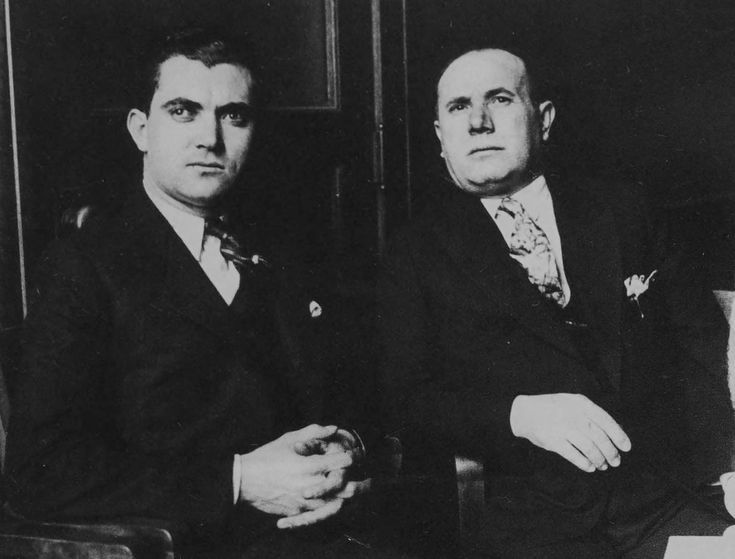
Giovani / John Scalise & Alberto Anselmi, The Murder Twins
There have been many different iterations of the same story where Capone beat them with a baseball bat or future Outfit boss Tony Accardo beat them with a baseball bat, and that is how he got the name “Joe Batters”. However, it’s not clear if Al Capone was even in attendance at the banquet at the time.
Dean O’Banion’s murder would shape Chicago’s gangland dramatically and would lead to a period of all-out mob warfare, culminating in the St. Valentine’s Day Massacre in 1929.
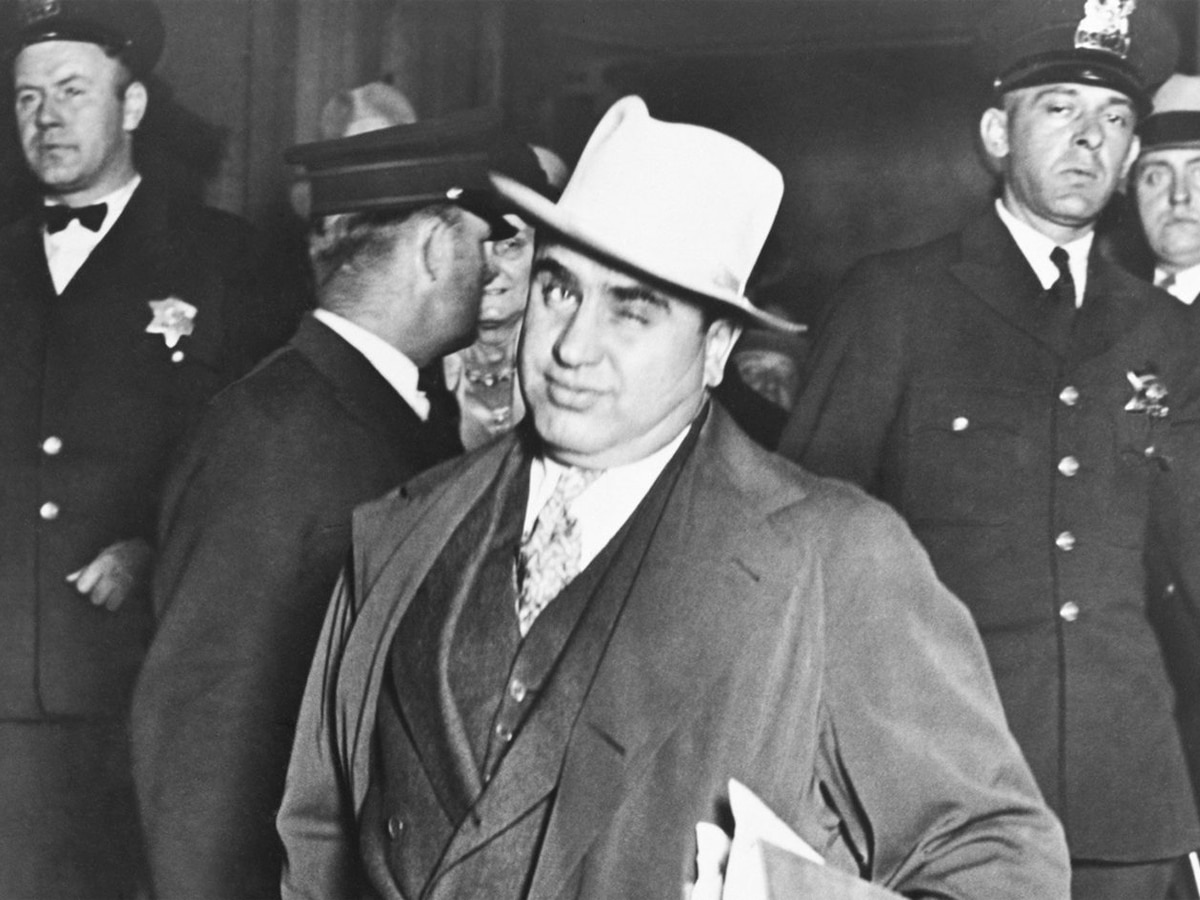
Al Capone
Become A Supporter
If you like what we do and would like to support our work, please consider donating.
Liking, Sharing and Commenting on our social media is always the best way to show support
Ralph Sheldon
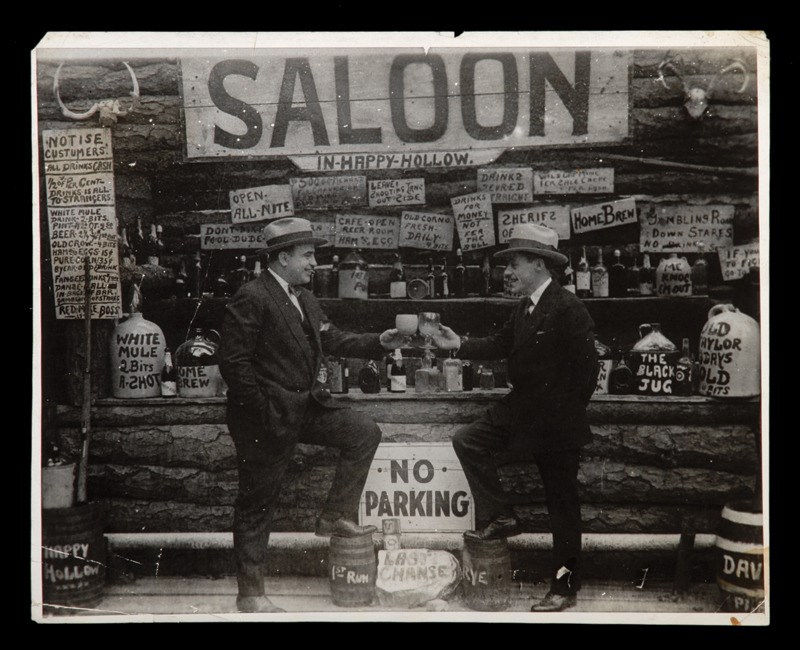
Al Capone (left) and Ralph Sheldon (right) in Hot Springs, Arkansas.
There had been an uneasy truce between the gangs until about 1923 when war broke out between the Soltis / McErlane, backed by John Torrio, and the Southside O’Donnells.
The gang war eventually ended when Edward “Spike” O’Donnell was forced to leave Chicago after being wounded by Frank McErlane in what was one of the first recorded uses of the Tommy Gun or what would become known as the “Chicago Typewriter” on September 25, 1925.
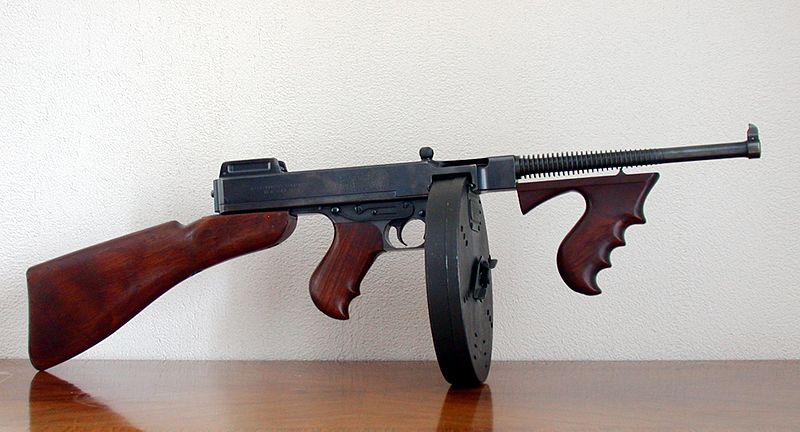
The Thompson Sub Machine Gun, Tommy Gun, Chicago Typewriter
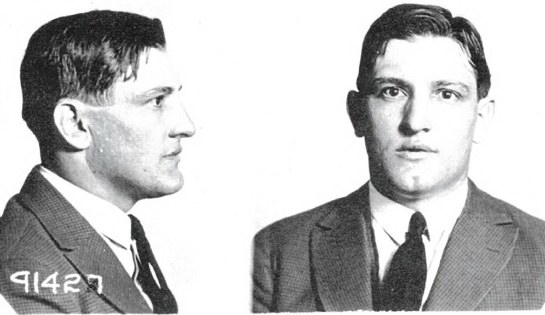
Danny Stanton
The Sheldon / Stanton Gang quickly became a major alcohol suppliers in Chicago’s Southwest Side and one of the main suppliers to Al Capone.
The Sheldon’s main rivals were the Saltis-McErlane Gang and the Southside O’Donnell’s. In October 1925 Frank McErlane used his favorite new gun again in an attack on the Sheldon gang, a saloon that was a hangout for the Ragen’s Colts gangsters. This led to a strange three-way gang war breaking out, both the Southside O’Donnell’s and the Sheldon / Stantan gang fought the McErlane / Soltis gang. The O’Donnell and Sheldon / Stanton gangs didn’t fight each other, however.
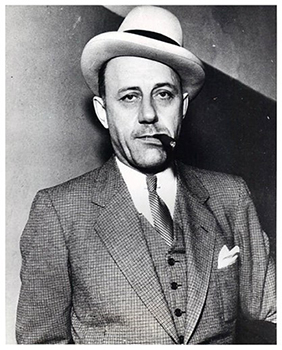
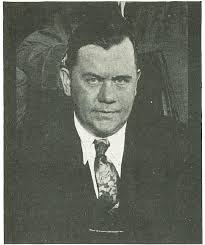
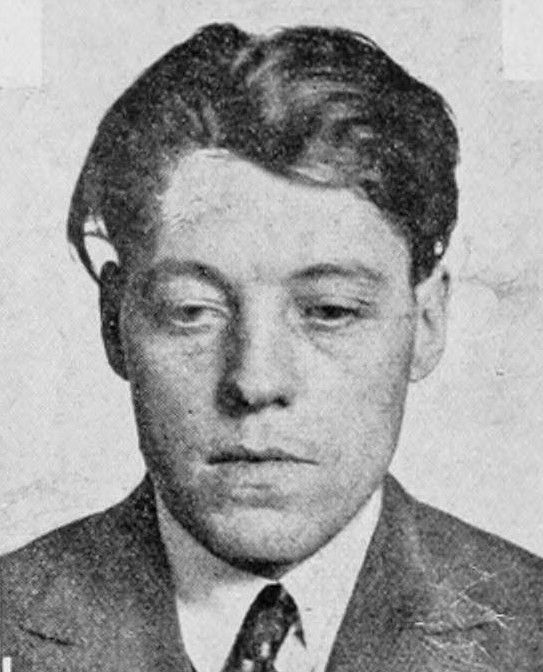
Edward “Spike” O’Donnell
Frank McErlane
Ralph Sheldon
The Stanton Gang was eventually absorbed by Al Capone’s Chicago Outfit.
Hymie Weiss - The Only Man Capone Feared
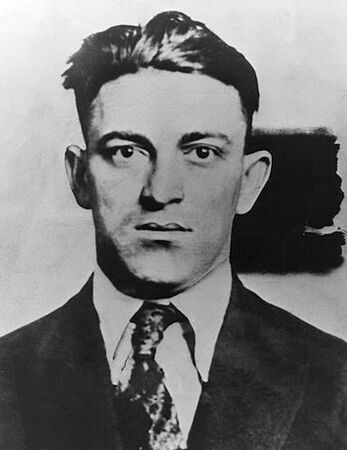
Earl J. “Hymie” Weiss
On January 25, 1925, it is believed that Drucci, Weiss, and Moran pulled up alongside Al Capone’s car and opened fire, they missed Capone however.
Twelve days later there was an attempted assassination attempt on John Torrio later. It’s believed that “Schemer” Drucci was the getaway driver while “Bugs” Moran and Hymie Weiss blasted John Torrio, leaving him seriously wounded, this was enough for John Torrio and left Al Capone as the Boss of Chicago. When John Torrio recovered he went to jail for a prohibition violation, he retired from crime and went to live in Sicily after he finished his sentence.
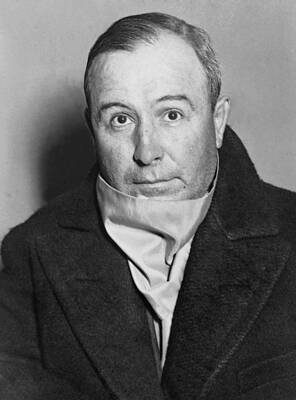
John Torrio leaves hospital having survived an attempt on his life.
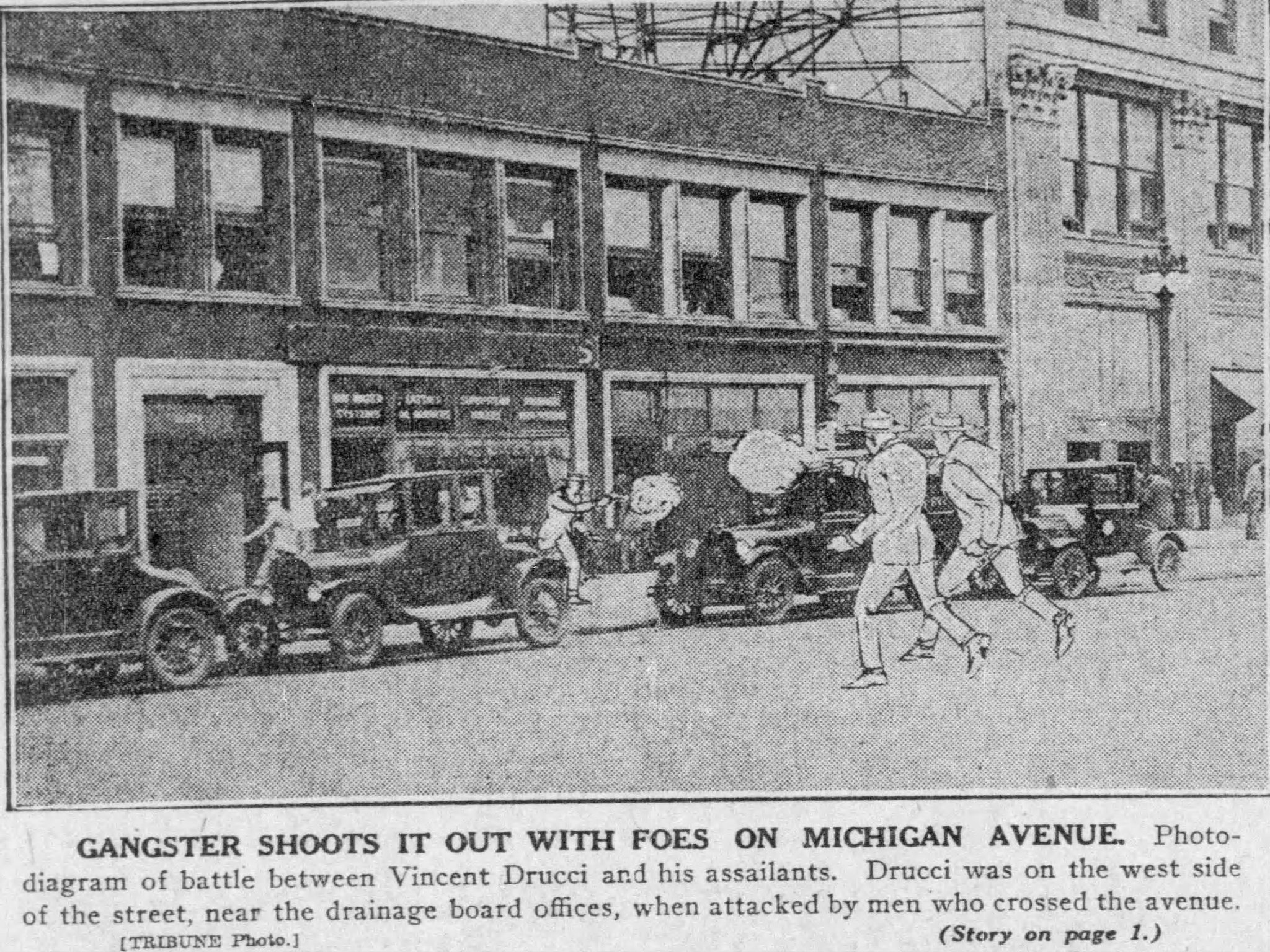
Chicago Tribune
A gunfight raged up and down the street with dozens of shots being fired by the attackers, while Drucci and Weiss returned fire, one onlooker was hit in the leg by shrapnel or a stray bullet. “Schemer” Drucci added to the drama by hopping on a car running board, waving a gun at the driver, and ordering them to follow the escaping attacker’s car. One Capone gunman was later arrested and was identified as Paul Valerie, better known as Paul “The Waiter” Ricca.
Drucci was arrested and claimed that it was a robbery and that the attackers were trying to rob him of $13, 200 he had in his pocket.
A month later on 20th September 1926, one of the most spectacular mob hits in Chicago took place, the attack on the Hawthorne Inn, Al Capone’s headquarters in Cicero
Scene from the 1967 movie The St. Valentine’s Day Massacre
Some say about 200 to 1,000 rounds are poured into the Hawthorne Hotel. A man and woman were injured but the target Al Capone escaped.
In recent times it has been discovered that the attack was coordinated with mobsters from the McErlane / Soltis gang from Chicago’s South Side. They had once been allied with Torrio and Capone. Frank McErlane, who was one of the leaders of that gang, arranged from prison with his brother Vincent to coordinate with the Northside Gang.
The war between Capone and the North Side Gang reached a peak in October 1926. A peace conference was arranged between the warring parties, although Al Capone didnt attend in person, Tony Lombardo was his emissary. Peace was on offer if O’Banion’s killers, believed to be Scalise and Anselmi, were handed over or killed, through Lombardo on the telephone Capone refused, reportedly saying “I wouldn’t do that to a yellow dog!”.
Earl “Hymie” Weiss was murdered less than two weeks later.
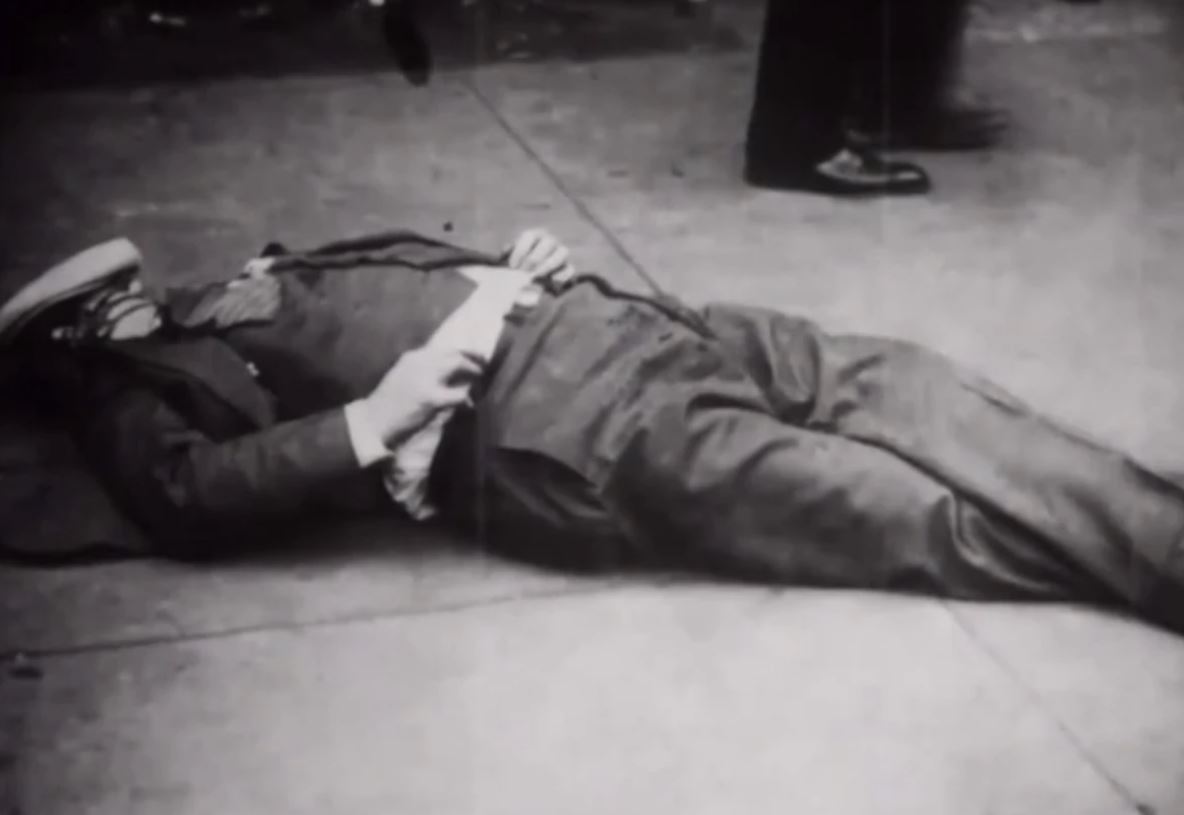
Hymie Weiss Murder Scene
The assassination of Hymie Weiss was an impressive operation involving at least two separate hit teams stationed in different buildings directly across the street from Schofields. The technique used to get Weiss was named the “Rented Ambush”, where gunmen hired apartments near where their targets would be and killed them at the best opportunity. There were bullets lodge, which still bears the scars, in the walls of the Holy Name Cathederal across the street.
At 4 O’clock on the 11th of October 1926, as Weiss was leaving the court to return to Schofields Flowershop, gunmen opened fire with a machine gun and an automatic shotgun from buildings across the street. Some witnesses say they saw gunmen on the ground too, who were shooting at Weiss
Weiss and one of his men Paddy Murray were fatally shot, William O’Brien, who was an attorney was hit four times but managed to stagger to hide at a stairwell. An investigator who worked with William O’Brien was wounded along with Weiss’ bodyguard Sam Pellar.
In October 1926 a peace conference took place between warring factions in the first Chicago Beer War, where they would secure a fragile peace.
Vincent “Schemer” Drucci and George “Bugs” Moran represented the North Side Gang having assumed control of the gang after the deaths of Dean O’Banion and Hymie Weiss.
William “Klondike” O’Donnell and his brother Myles were from the West Side O’Donnell’s.
Ralph Sheldon was present, representing his faction that had split from the Soltis / McErlane Gang.
The Soltis / McErlane were represented, although both Frank McErlane and Joe Soltis were in prison awaiting separate trials at the time.
The South Side O’Donnells didn’t attend or take part in the peace conference.
The Genna Brothers Gang, who were once a rival outfit to the North Side Gang, had been all but wiped out at this stage.
Peace held for a while but the shootings and killings within the gangs continued. The peace pact broke down within a couple of months and so, the second Beer War began.
Become A Supporter
If you like what we do and would like to support our work, please consider donating.
Liking, Sharing and Commenting on our social media is always the best way to show support
"Bugs" Moran & The St. Valentines Day Massacre
Moran picked up where the others had left off. After the tit for tat the Northsiders decided to go after one of Capone’s top gunmen. On March 7th in 1928 its believed that the Gusenberg brother’s, Moran gangsters pulled off an attempt on the life of “Machine Gun” Jack McGurn in the McCormick Hotel. Witnesses say they saw a car pull up outside the smokeshop in the hotel, two men got out and ran into the smokeshop and opened fire on McGurn, wounding him and another customer.
The peak of the warfare seen a carefully planned and executed ambush played out to make sure that George “Bugs” Moran and his top men were dead, thus eliminating Capone’s main rival, Moran never made it to the location that day, and he survived, although seven unlucky victims didnt survive
Throughout the gang war, both had survived several assassination attempts. On one occasion, Moran, Weiss, Drucci, and some of their men drove a convoy of cars past the Hawthorne Hotel where Capone and his men were having lunch and sprayed the building with lead, miraculously no one was killed and few had minor injuries.
A plan was hatched where they would try to trick Moran into thinking he was buying a shipment of hijacked booze from Canada, the drop-off point was to be the SMC Cartage Company garage at 2122 North Clark Street, a property belonging to Moran. The idea behind the plan was to kill Moran and his men while they were all in the building together.
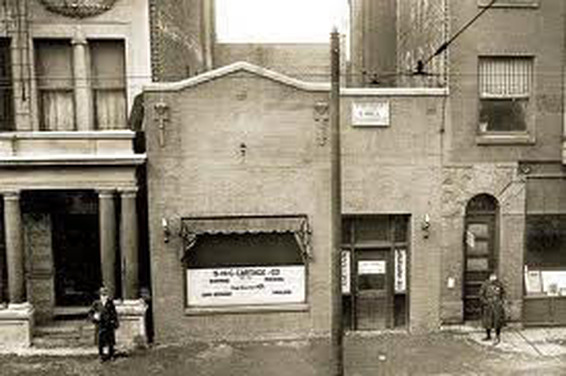
SMC Cartage Company warehouse at 2122 North Clark St
A police car had arrived outside the building with two men dressed in uniform and two more in civilian clothes. Inside the building were six of Moran’s men. The last to arrive was Albert Weinshank, as Weinshank made his way into the warehouse, he was grabbed by the two police officers and they forced him inside. Believing the gangsters were being raided, as they were gangsters they knew the drill so they lined up against the wall with their backs to the police.
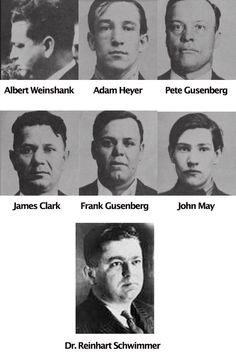
Six of the gangsters died instantly but one remained alive, although barely, Frank Gusenberg was taken to hospital but died later that day, but not before the police could talk to him. As soon as he had arrived at the hospital and been stabilized by doctors, the police questioned him and wanted to know how he had gotten 14 gunshot wounds, and who had shot him. He replied “No one shot me,” Frank Gusenberg died three hours later.
The victims that day were brothers Frank & Pete Gusenberg, long time members of the Northside Gang, John May, Albert Weinshank, Adam Heyer, Albert Kachellek aka James Clark. Also there was Dr. Reinhardt Schwimmer, who liked to hang around with gangsters but wasnt one himself.
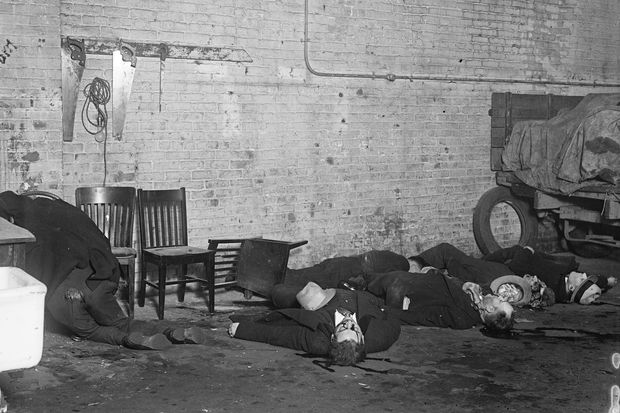
Vicitms of the St. Valentine’s Day Massacre
Highball a German Shepherd, that belonged to John May, the youngest person to be killed in the St. Valentine’s Day Massacre. Highball was the only eyewitness inside the garage where the massacre happened. And endured the whole incident. When police arrived, Highball was found chained, trembling, and howling. Sadly Highball was so traumatized he had to be put down.
No one was ever charged for the crime and no actual suspects were named, although there are plenty of guesses as to who it was. Some of the suspects included:
Gus Winkler & Fred “The Killer” Burke, who were both former members of the Egan’s Rats, a gang from St. Louis, Machine Gun Jack McGurn, John Scalise, and Alberto Anselmi. All of which were certified killers and could have easily pulled this off. Some evidence, from the wife of Gus Winkler, says that she saw both Gus Winkler & Fred Burke dressed in uniforms on the morning of the massacre, these were prime suspects, though they were never arrested.
In the fallout of the St. Valentine’s Day Massacre, George “Bugs” Moran stated, “Only Capone Kills Like That”. Having heard what Moran had said, Al Capone responded with “The Only Man That Kills Like That Is Bugs Moran”
After the St. Valentine’s Day Massacre George “Bugs” Moran held on for a while with a much weakened Northside Gang. Eventually, Moran faded away from bootlegging in Chicago altogether. Moran continued his life of crime, getting picked up by police for petty crimes. He was arrested for robbery in 1939 and sent to prison until 1944. “Bugs” Moran was arrested again in 1945 and sent to prison for 20 years, he died in prison in 1957, ironically outliving Al Capone.
The "Terrible" Touhy's
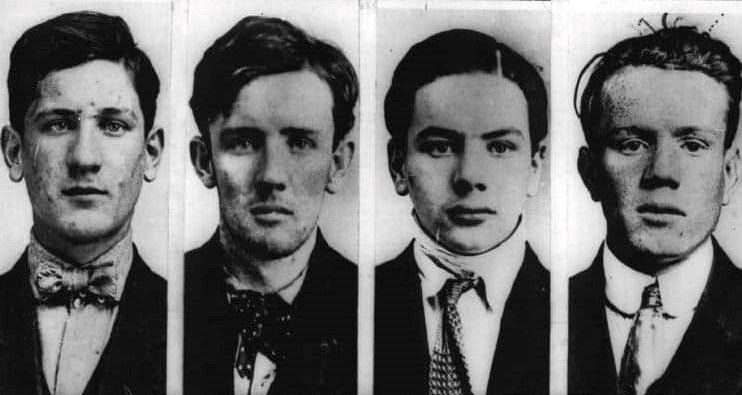
Some of Roger Touhy’s brothers. From left to right Joseph, James, Thomas and Ed.
Roger Touhy, one of the “Terrible Touhys” was the most notable name among five of the six Touhy boys who became part of a bootlegging gang.
Touhy’s territory was in Northern Chicago where he had partnered with Matt Kolb, who was formerly partnered with Marty Guilfoyle. Touhy and Kolb were pulling in an estimated $1 million a year from beer sales alone. Naturally, this attracted Al Capone’s attention.
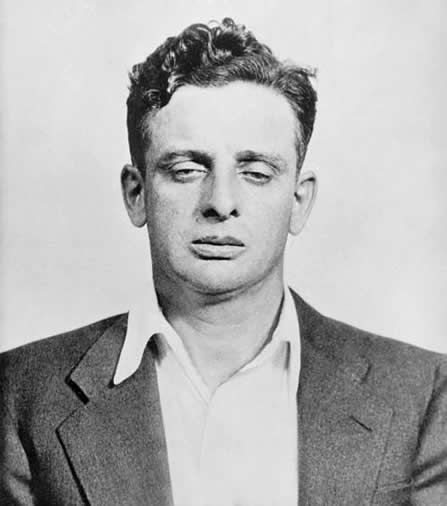
“Terrible” Roger Touhy
Joeseph Touhy was killed in 1929, Joeseph and a group of his men were breaking up a Capone speakeasy, that Capone had set up within Touhy’s territory. That didn’t stop Capone from continuing his take-over, nor did it stop the Touhy’s.
Trying to strong-arm Touhy did not work either, some reports suggested that Capone sent his goons to talk to Touhy, Touhy arranged for locals to come to his hangout, look menacing, and be armed with all kinds of guns, giving the appearance of the Touhy gang being “bigger” than they really were.
The charades, however, didn’t take away from the Touhy’s ability to fight Capone. In 1932 the Touhys ambushed Charles “Red” Barker, one of Capone’s top union men, outside a hotel in Northwest Chicago. Apparently, William “Three Finger Jack” White, Claude “Screwey” Maddox, and William “Klondike” O’Donnell all narrowly avoided being hit.
Subsequently, the Touhys went on the offensive leading to a string of ambushes and murders throughout 1932. This offensive for the most part was met with firstly political and official pressure, the Chicago Police shut down every Touhy speakeasy and operation in the Northwest Side of Chicago.
Al Capone was brought to trial and sentenced during his 1931 tax trial. Capone’s Outfit was now under the control of Frank Nitti, who had a different style of leadership, Nitti preferred to handle things that didn’t attract the spotlight.
In 1933 everything changed for the Touhys, Roger in particular.
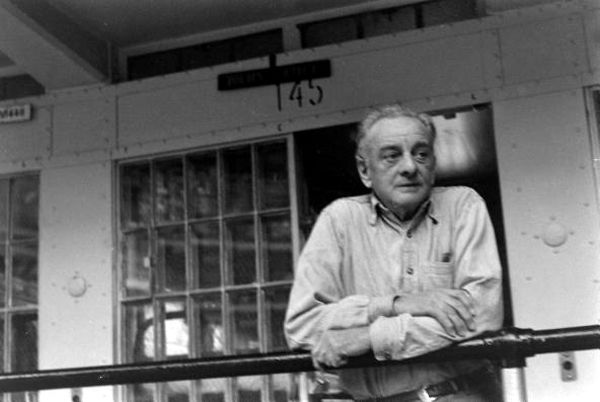
Roger Touhy
This miscarriage of justice lasted years. The drama didn’t end there, Touhy and some prisoners managed to escape prison escape prison, and go on the run, being caught and sent back to prison, then ended in Touhy’s parole. However within weeks of his release from prison, “Terrible” Roger Touhy was gunned down.
“Terrible” Roger Touhy lies on his sister’s front porch having been shot in 1959, Touhy would die of loss of blood hours later on the operating table.

Roger Touhy after being shot
As Touhy was in the hospital, he told medics and police,
“I’ve been expecting it. The bastards never forget.”
The Untouchable's
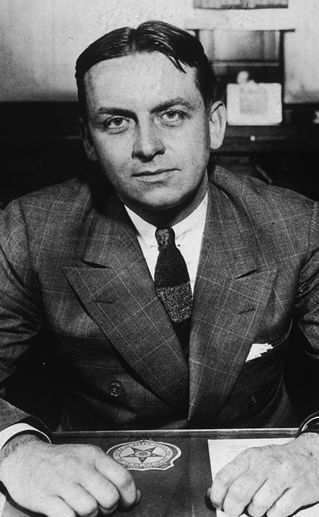
Elliot Ness
A unit of Prohibition agents was set up, which included the famous Elliot Ness who led a team of agents, they earned the nickname, The Untouchables, because they weren’t as easily bribed and corrupted as the local police and authorities. The Untouchable’s main task was to take down Al Capone, they succeeded in getting Capone on thousands of Prohibition violations, however, the government decided not to pursue the Prohibition violations and instead pursued income tax violations.
Capone would be on the receiving end of the law for most of 1929 & 1930. Capone was arrested on the 27th of March 1929 by FBI agents, leaving court. In May 1929 Al Capone was arrested for carrying a concealed weapon, for which he was sentenced to 1 year in Eastern State Penitentiary in Philadelphia. After he was released in 1930 Capone was named Public Enemy Number One.
Al Capone was sentenced to 11 years in prison and given a $50,000 fine, plus any court costs in October 1931. He was also held liable for $215,000 in tax arrears on an estimated $1,038,654 earned from 1925 to 1929.
Capone’s underboss, the next in line to take over from Capone, was Francesco Nitto better known as Frank Nitti. Nitti had been in charge of all the money flowing through the Capone Organization. Under Nitti the Outfit would start branching out, they would no longer just focus on alcohol, gambling, and prostitution and move into labor racketeering and unions.
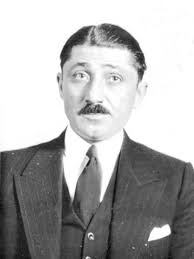
Frank Nitti
Become A Supporter
If you like what we do and would like to support our work, please consider donating.
Liking, Sharing and Commenting on our social media is always the best way to show support
The Board of Director's

William “Klondike” O’Donnell, William “Three-Fingered Jack” White, Murray “The Camel” Humphreys, Marcus Looney, and Charles Fischetti.
The scene was described to the media by Detective Shoemaker like this; the gangsters were meeting like the presidents of banks, in an expensive directors’ suite. At the head of the large mahogany table was Murray “The Camel” Humphreys, who was one of Al Capone’s trusted lieutenants. Next to Humphreys, to his right was sitting William “Klondike” O’Donnell the Southside Beer Baron. On Humphreys’ left was sitting Marcus “Studdy” Looney a labor racketeer and business agent for the Teamsters Union.
Along the sides of the table were other racketeers and union business agents such as Thomas Cullen, John O’Brien, Joe Marino, Sam Alex, William Martin, and Charles Sullivan, a labor racketeer and brother-in-law of the recently deceased Charles “Red” Barker.
Charles Fischetti a labor racketeer and a former bodyguard of Al Capone’s. At the bottom end of the table was sitting William “Three Finger Jack” White. In the center of the table was a gold frame with the photo of Charles “Red” Barker.
“Red” Barker had been gunned down on the street by the Touhy Gang with a total of 18 bullets lodged in him. In gangland tradition, Barker had a huge send-off, with estimates of up to four thousand mourners and curious on-lookers.
This group was in charge of the union take-over when the Outfit branched out from gambling, alcohol, and prostitution into labor racketeering among other more “legitimate” rackets.
A surprised Detective Shoemaker walked into the room and was greeted by Murray Humphreys, sitting in his chair at the top of the table “Ah, how do you do. We meet again”. Shoemaker searched Humphreys and found a gun, as he searched the rest of the members of the board he found a gun on Charles Fischetti, another when he searched William “Three Finger Jack” White, and a fourth gun in a drawer in the desk.
The entire board of directors plus all of their bodyguards were brought down to the station, where Shoemaker was thinking of what charges should be brought against them, he knew they were up to something they shouldn’t be but wasn’t sure what it was. “I understand they’ve gone into the labor rackets”
In a separate raid across town on the Westside in a “political” club the police arrested other Outfit mobsters such as Sam “Golf Bag Sam” Hunt, “Machine Gun” Jack McGurn, Tony Accardo, Rocco de Grazio, and four other gangsters.
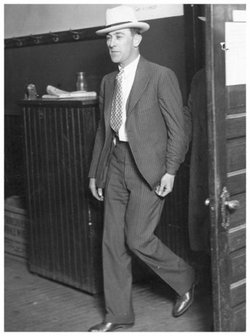
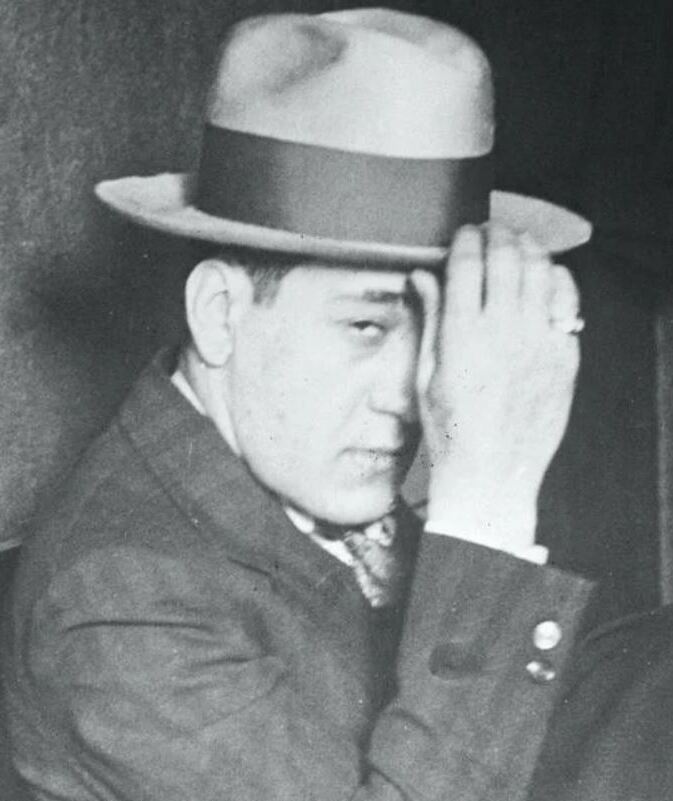
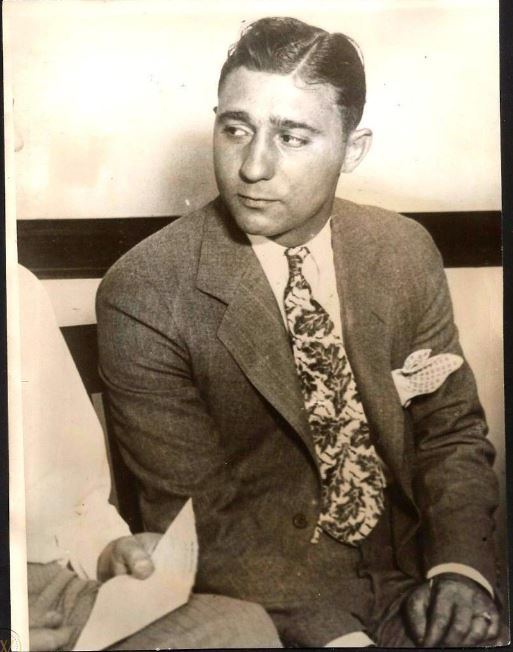
Sam “Golf Bag” Hunt
Anthony ” Tony Batters” Accardo
“Machine Gun” Jack McGurn
In The End
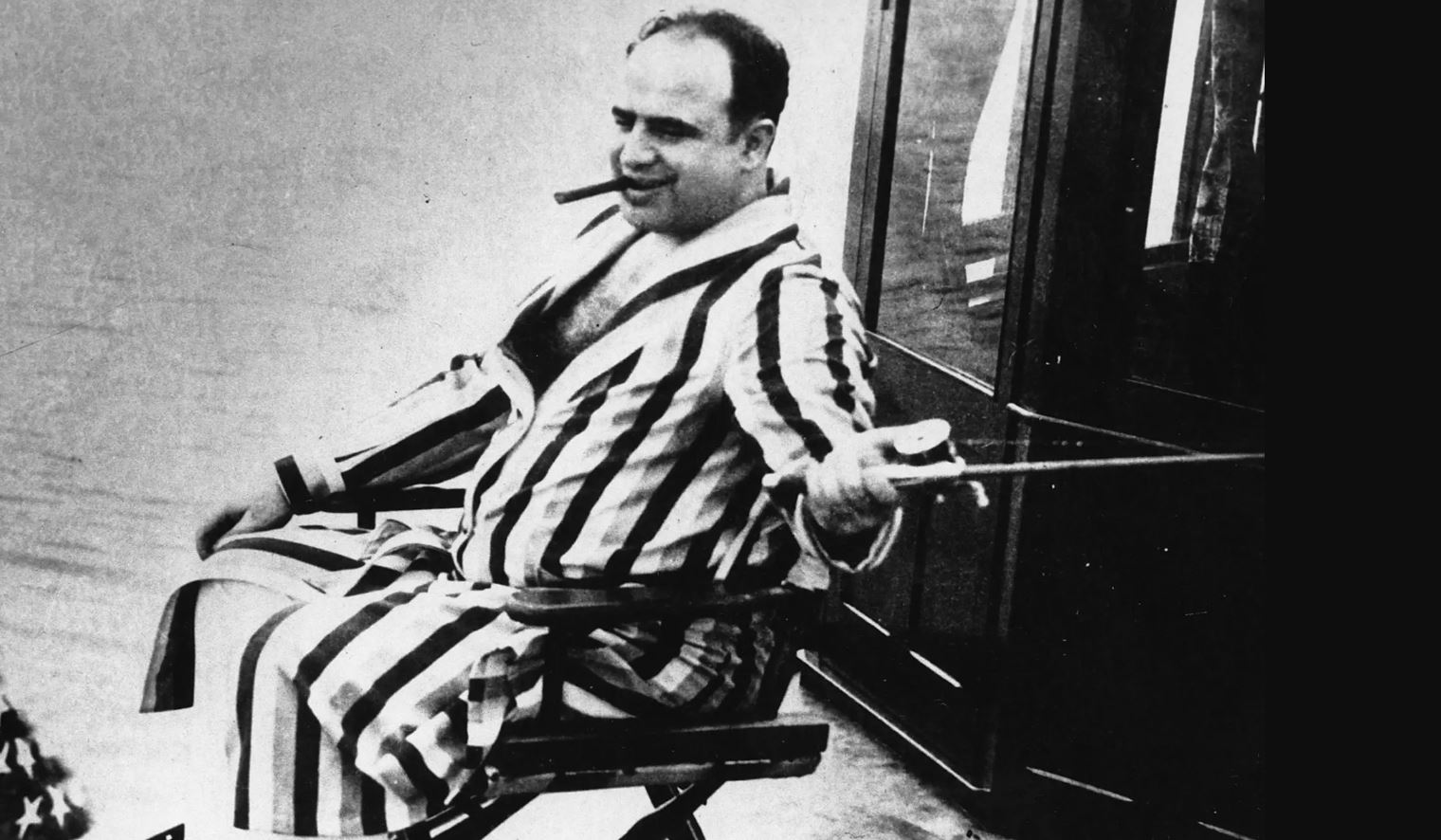
While he was in prison Capone was diagnosed with syphilis, by 1939 his condition was deteriorating and so was paroled.
Al Capone spent the rest of his life living in Florida, where he died in 1947, surrounded by his wife Mae, his son “Sonny”, also living in Miami with them was Mae’s brother Daniel Coughlin and his wife. Daniel would act as a part time chauffeur for Capone.
Frances “Sonny” Capone would live a normal law abiding life, he married an Irish woman and teenage sweetheart by the name of Diana Ruth Casey. It appears that “Sonny” somewhat struggled with shaking his fathers legacy, for example, used his fathers old aliases, Brown, to enroll into university and at different times throughout his life. “Sonny” died in California in 2004.
https://www.chicagotribune.com/2022/03/17/northwest-side-mob-boss-roger-touhy/
https://www.myalcaponemuseum.com/id152.htm
https://www.myalcaponemuseum.com/id139.htm
https://chicagology.com/notorious-chicago/gangland4/
https://www.facebook.com/photo/?fbid=764654758790872&set=a.462224642367220
https://www.historydefined.net/how-did-al-capone-get-his-infamous-scars/
https://allthatsinteresting.com/mae-capone
https://www.chicagotribune.com/
https://medium.com/@andrew_ward/aka-big-brother-dc18cd3c3d46
https://nypost.com/2016/10/16/isolation-madness-and-syphilis-inside-al-capones-final-years/
https://themobmuseum.org/blog/one-hundred-years-ago-murder-of-big-jim-colosimo
https://homicide.northwestern.edu/crimes/mcswiggin/
https://www.chicagomag.com/arts-culture/june-2017/beer-wars/
https://chicagology.com/notorious-chicago/
https://voicemap.me/tour/chicago
https://www.fbi.gov/history/famous-cases/roger-the-terrible-touhy
https://manofmany.com/lifestyle/al-capones-missing-millions
https://miami-history.com/tag/al-capone/
Become A Supporter
If you like what we do and would like to support our work, please consider donating.
Liking, Sharing and Commenting on our social media is always the best way to show support

